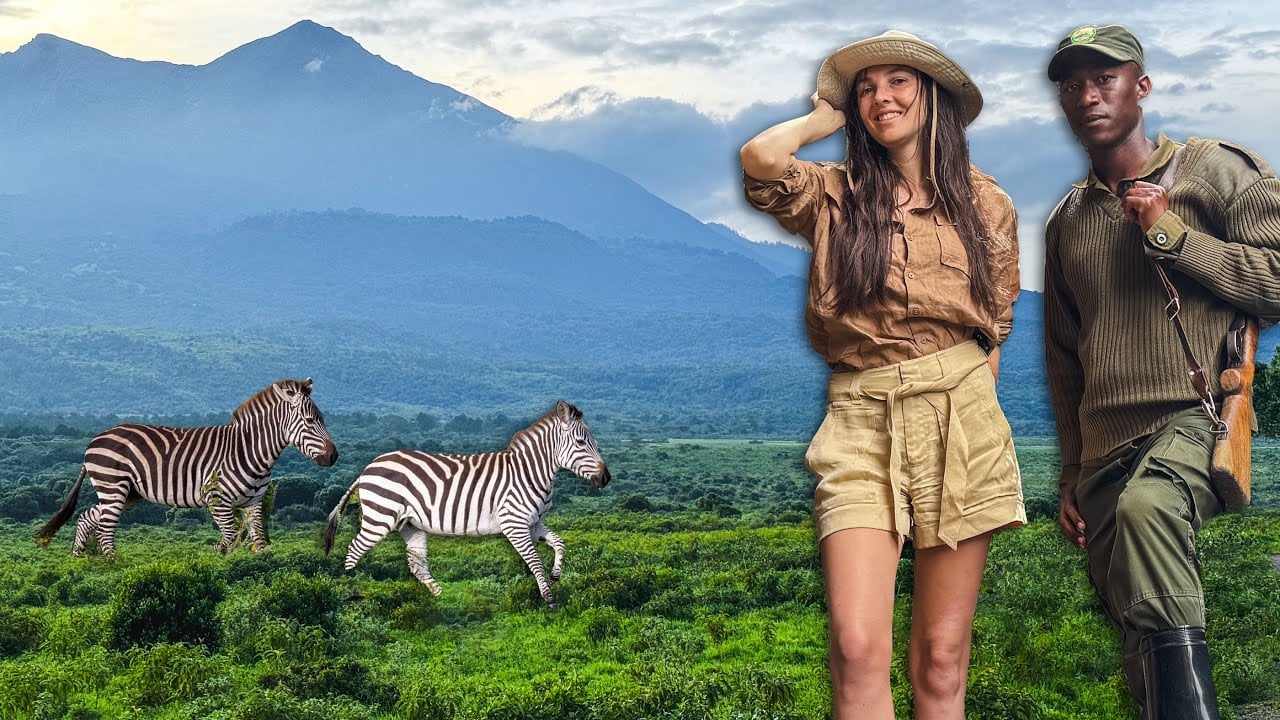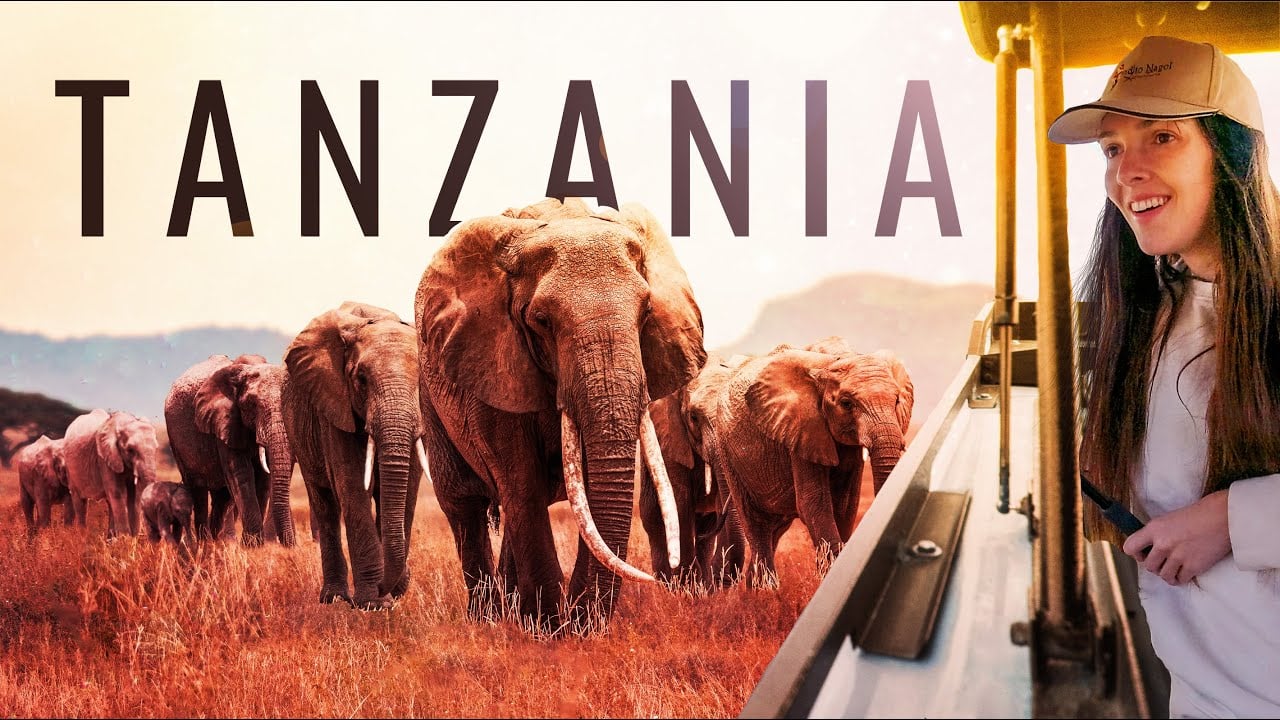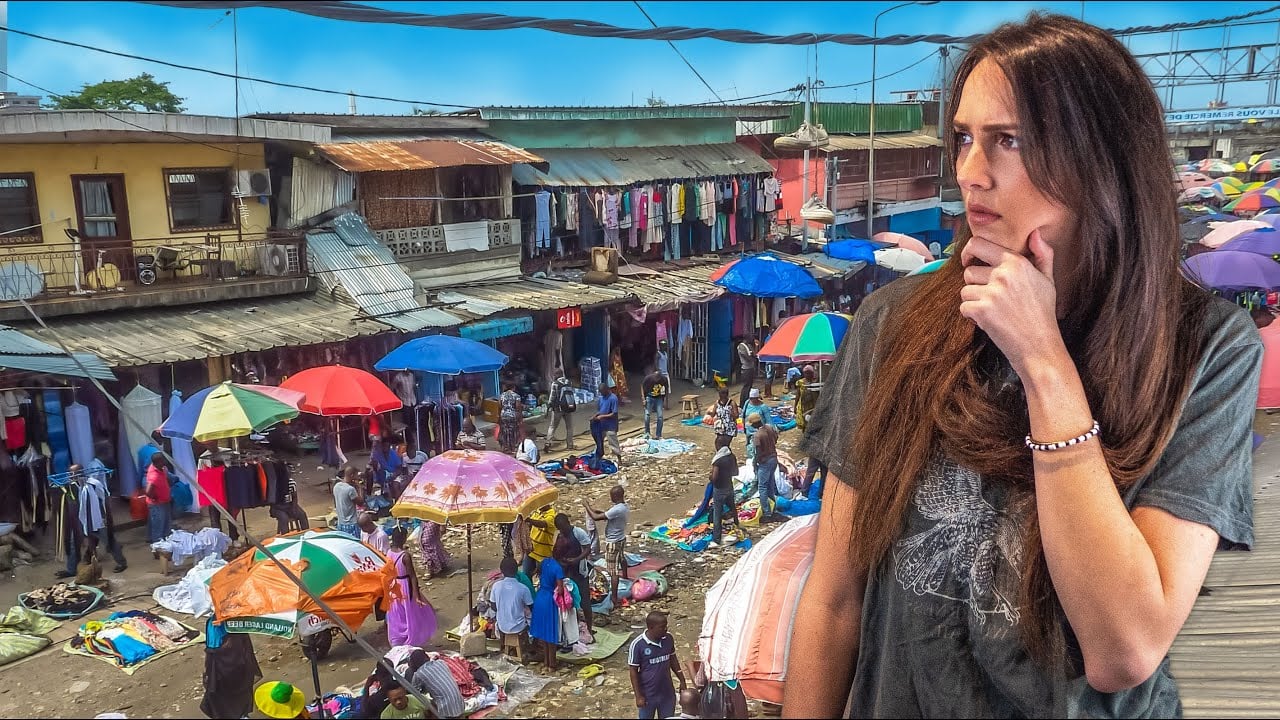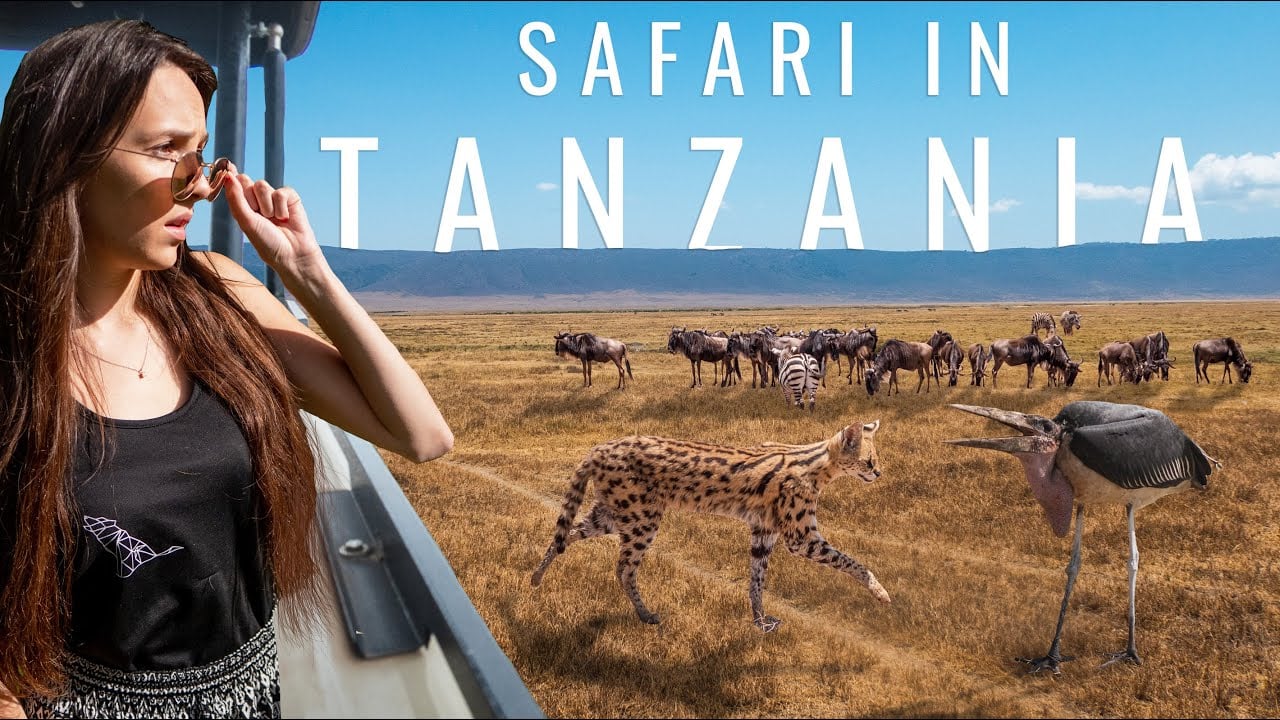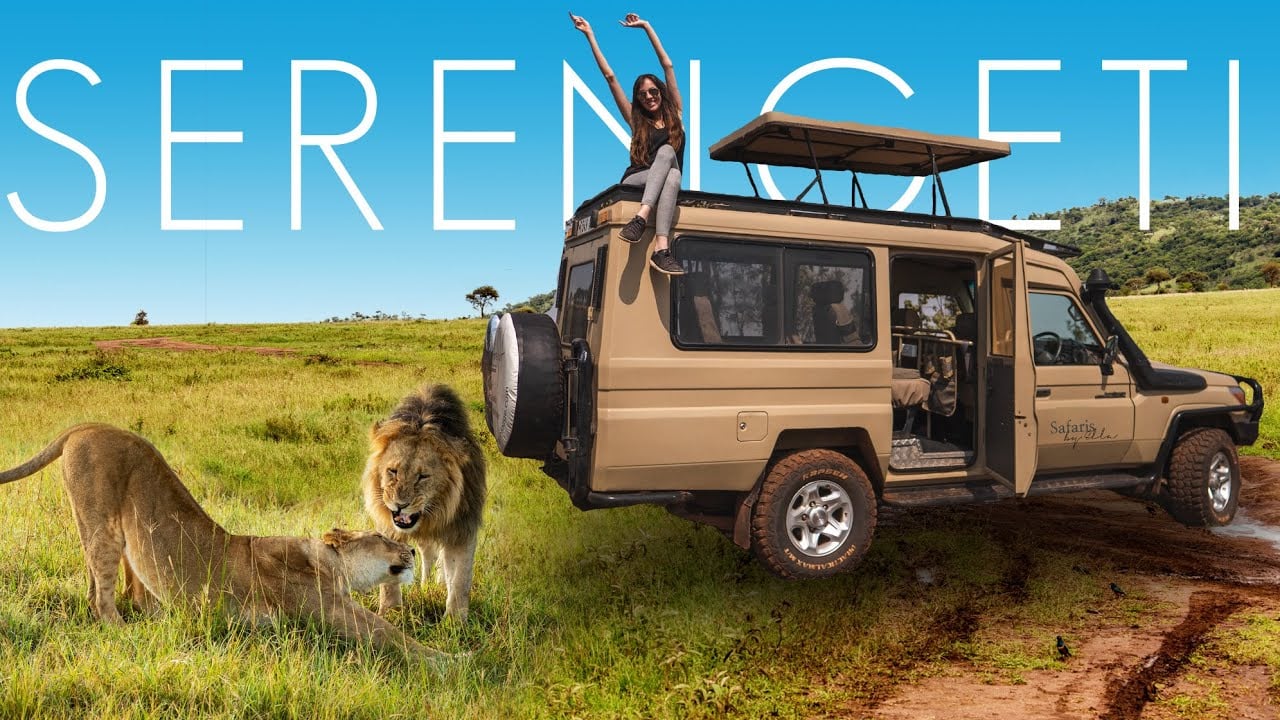Tanzania is hands down one of my favourite countries on the planet.
It’s here that I’ve had some of my very best wildlife encounters, from witnessing a lioness streak through the grass in pursuit of a zebra, to gawping at the marvel of the great wildebeest migration, watching hundreds of wildebeest leap into the crocodile-infested Mara River. These memories will no doubt stay with me for a lifetime.
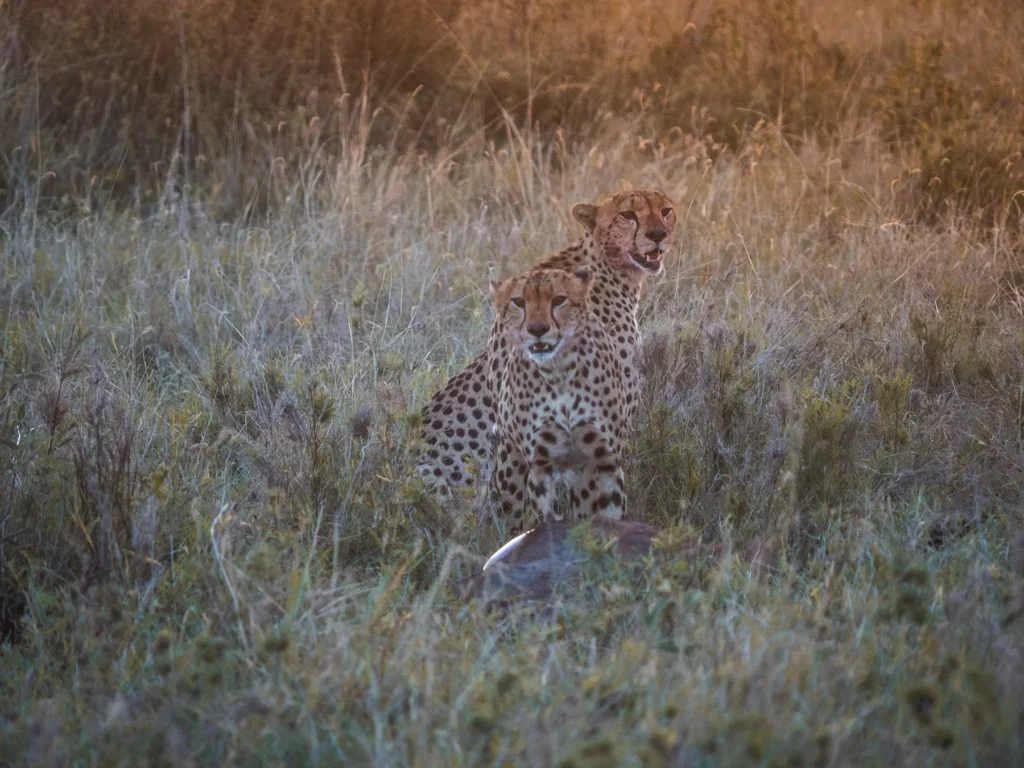
If you’re looking for the ultimate safari experience, look no further than Tanzania. Home to the sprawling Serengeti National Park and the awe-inspiring Ngorongoro Crater, these unique landscapes are home to some of the highest concentrations of animals in Africa who are just waiting to wow you with some incredible sightings.
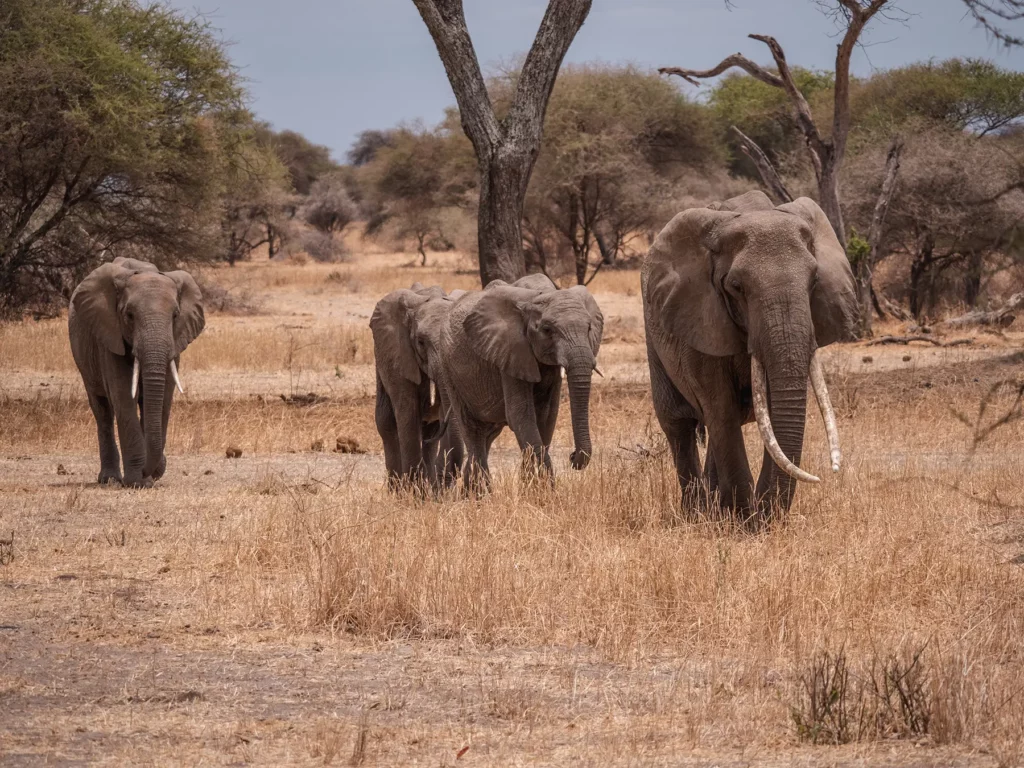
If you want to get the most out of your Tanzania trip then a 2-week itinerary allows you plenty of time to see the country’s safari highlights but without rushing. Having more time in each location increases your chances of having memorable wildlife sightings and encountering all of the Big Five.
In this guide I’m going to bring you the ultimate 2-week Tanzania safari itinerary. I’m going to provide you with everything you need to know, including costs, tips for choosing the perfect tour operator, additional tricks to make your trip go smoothly and much more so that you can have the safari of a lifetime!
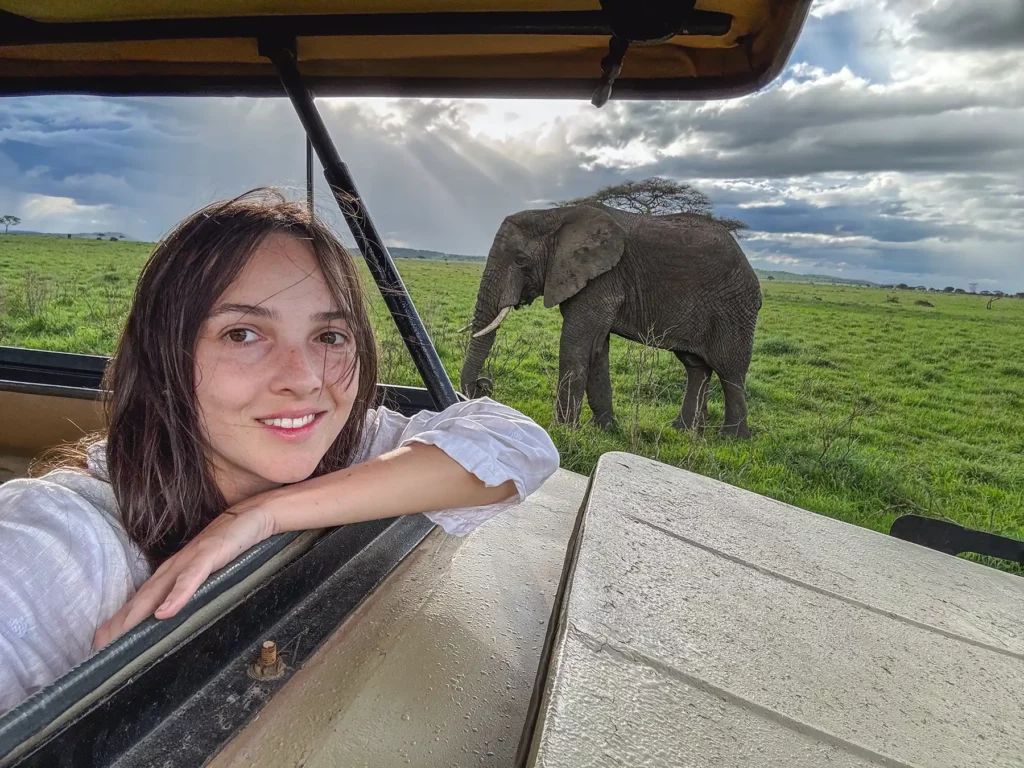
Embark on the Safari of Your Dreams
Save time and ensure an incredible safari experience by getting quotes from my recommended local safari companies
I’m here to make booking your perfect safari quick, easy and risk-free.
Join the rapidly growing tribe of over 1,000 travellers who’ve booked their dream safari using my insider tips and recommendations.

It takes under 60 seconds to fill out the form and in under 48 hours you will receive multiple, no-obligation proposals from my favourite local tour operators with glowing online reviews.
Get your free no-obligation safari quotes and my top safari tips and recommendations
Tanzania 2-Week Safari & Beach Itinerary Map
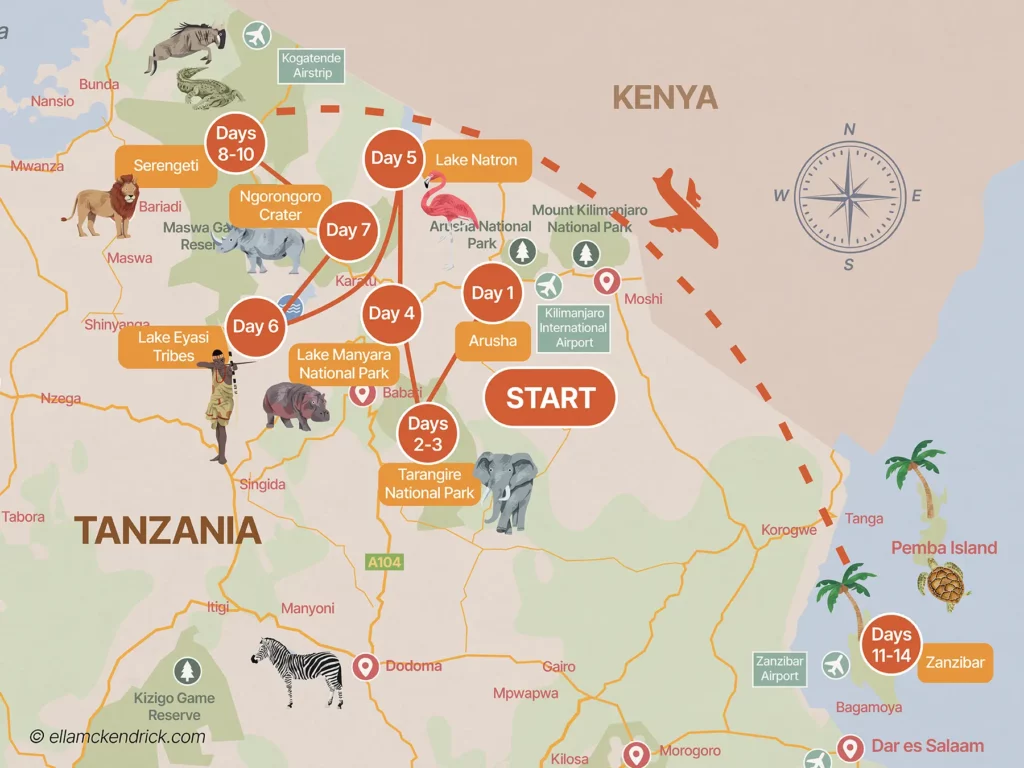
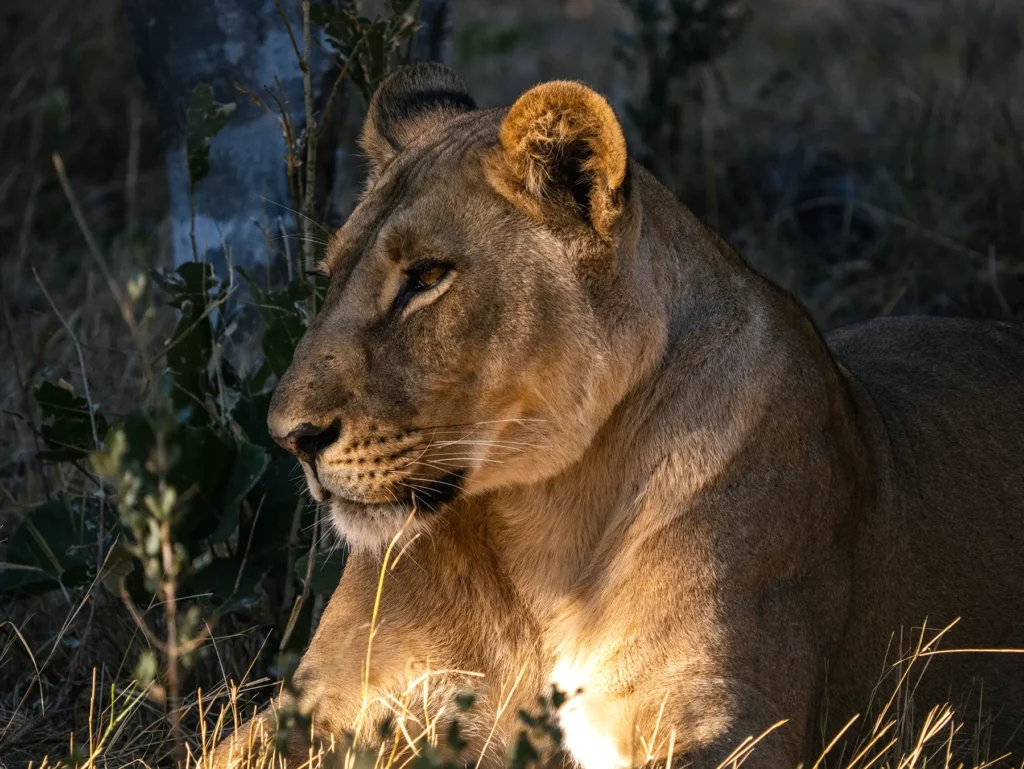
Why Go on Safari in Tanzania?
In my opinion Tanzania is one of the best places in the world to go on safari.
Tanzania is home to the legendary Serengeti National Park, the setting for the awe-inspiring Great Migration, where you can watch millions of wildebeest, zebras, and gazelles traverse the plains in the cycle of life and death.
Beyond the Serengeti, the Ngorongoro Crater, the caldera of a collapsed ancient volcano, offers a sanctuary to some of Africa’s densest populations of large animals, probably most famously, the Big Five (lions, leopards, elephants, rhinos and buffalos). There’s nowhere else on the planet like it!
As well as being a prime safari destination, Tanzania also houses the tallest mountain in Africa, Mount Kilimanjaro and the island of Zanzibar has some of the best beaches on the continent, meaning there really is something for everyone.

How to Book Your Tanzania Safari
Your safari in Tanzania is a journey that begins long before you set foot on the continent. The planning and booking process is a super important part of ensuring your adventure is everything you dream it to be.
With so many options at your fingertips, from self-drives to luxury fly-in safaris, navigating the booking process can seem daunting. I’m here to help and with a bit of guidance and strategic planning, bagging your spot on a Tanzanian safari can be a smooth and even enjoyable part of your travel adventure.
When it comes to booking your safari, There are four main options to choose from: self-drive, local tour operator, international tour operator and fly-in safaris.
Below I will dive into the pros and cons of each one to help you make the perfect choice.
Save time and ensure an incredible safari experience
Get quotes from the local tour companies I use to organise my own trips.
You’ll join the rapidly growing tribe of over 1,000 travellers who’ve booked their dream safari using my insider tips and recommendations.
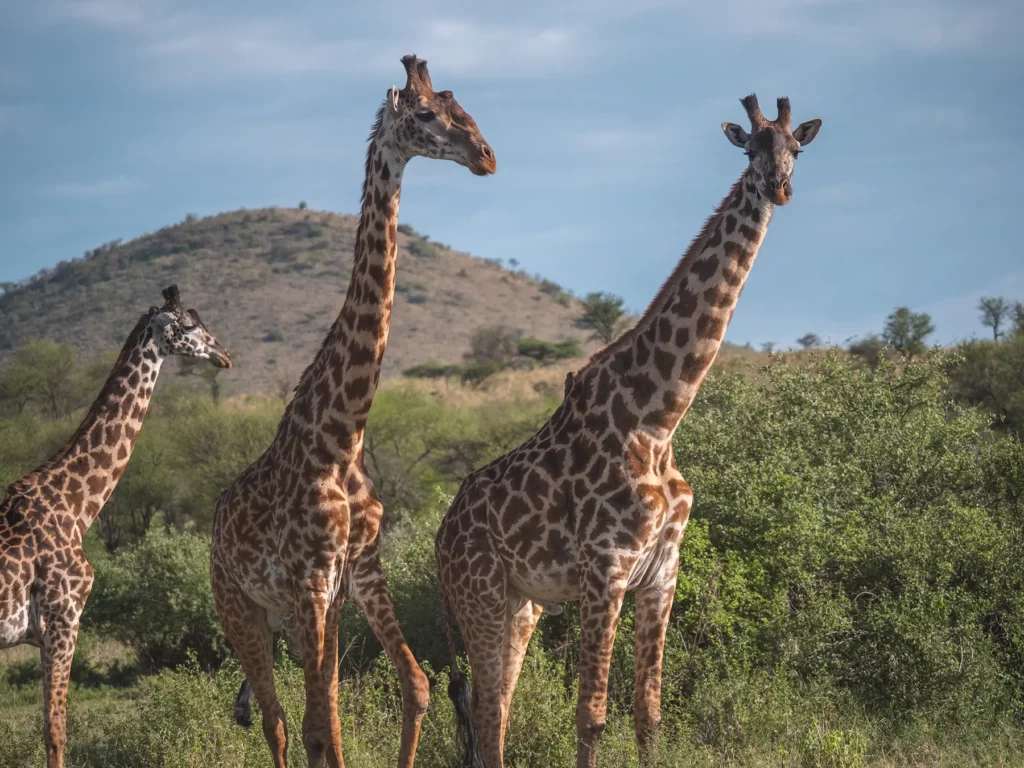
Option 1: Self-Drive Safari
Going on a self-drive safari in Tanzania offers a crazy sense of adventure and intimacy with the wild. It’s an option that appeals to the independent traveller, keen on building their own journey through the heart of Africa. Yet, it’s essential to weigh up the unique blend of freedom and challenge this choice presents.
A self-drive safari puts you in the driver’s seat, quite literally, allowing you to navigate at your own pace. Imagine the thrill of discovering a pride of lions basking in the early morning sun or encountering a herd of elephants as they traverse the savannah, all on your own schedule.
However, the allure of autonomy comes with its considerations. Tanzania’s national parks are vast and often remote, requiring a reliable and sturdy vehicle capable of handling rough terrains. A 4×4 is definitely necessary, ideally something like a Toyota Land Cruiser, known for its durability and off-road capabilities. Rental costs vary, but budgeting around $150-$200 per day for a vehicle equipped with camping gear is a good starting point.
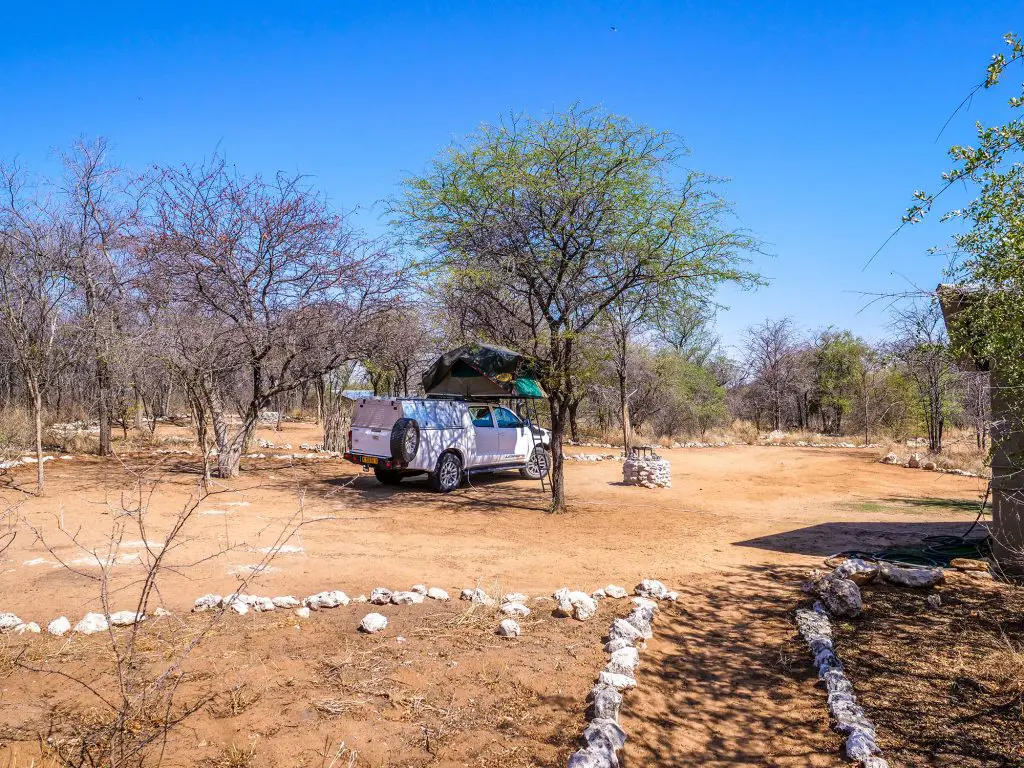
It’s also worth noting that national parks are very strict on what kinds of vehicles they let in. A 4×4 vehicle with high clearance is a prerequisite. Not just that but they favour Toyota Land Cruisers and Land Rover Defenders, so if you have a 4×4 and it isn’t one of these models of vehicle, it’s not guaranteed that you’ll be allowed entry.
Navigating the parks can be both exhilarating and daunting. While there’s a certain charm in the unpredictability of self-navigation, the reality of finding your way through unfamiliar terrain can be challenging. The parks are natural labyrinths, with limited signage and areas that can become impassable during the rainy season. It’s a test of both navigation skills and patience.
Park fees are a significant part of the safari budget, and in Tanzania, these fees are consistent regardless of how you choose to explore. For instance, entry into the Serengeti National Park costs approximately $70 per person per day, plus a vehicle fee. These costs can add up, especially for longer stays, making it important to plan your itinerary carefully.
It’s also worth noting that without the expert eyes of a guide, you might miss out on some of the more elusive wildlife, as guides are adept at spotting animals and understanding their behaviours.
On balance, I wouldn’t recommend a self-drive safari in Tanzania. The only cost saving you get by booking a self-drive safari is with not having a driver guide. Park fees and accommodation costs which always make up the majority of a safari cost will be the same. All in all, I don’t believe the cost saving is worth the extensive benefits of having a knowledgeable guide with you.
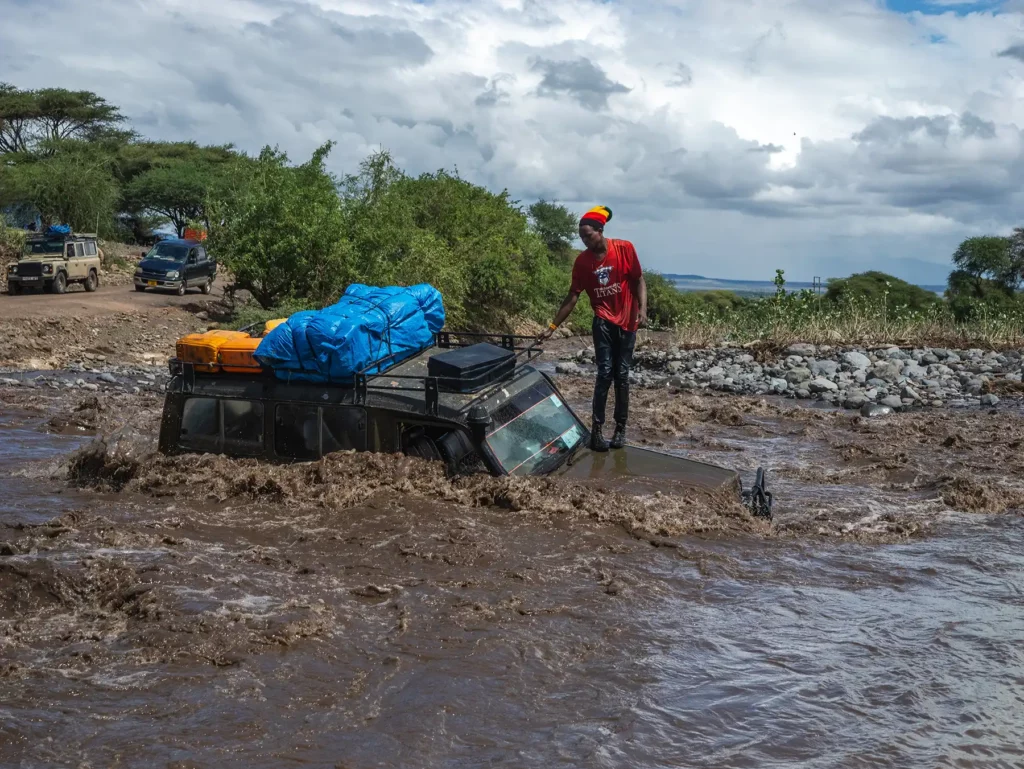
Option 2: Local Tour Operator
Choosing a safari with a local tour operator in Tanzania offers an unparalleled, hassle-free experience that might just redefine your idea of adventure!
While it’s true that this option can appear more costly upfront, the value and depth of experience it provides can far outweigh the price difference.
Firstly, I cannot overstate the competence of local guides. These professionals are not just drivers; they are true custodians of the wild, with an encyclopaedic knowledge of the ecosystems, animal behaviour, and the best times and places to witness the majestic wildlife of Tanzania.
Moreover, local tour operators have the advantage of established relationships within the parks and lodges. This often translates to smoother entry processes into parks, preferred access to prime viewing spots, and sometimes even discounts or value-added services at accommodations. The convenience of having all logistics handled by experts who understand the ins and outs of Tanzania’s safari circuits is unbelievably beneficial—allowing you to focus solely on the experience.

Safety and comfort are further enhanced when choosing a local tour operator. Vehicles are specifically designed for safari conditions, offering not only a better view but also ensuring safety in the wild. Operators are adept at handling any unforeseen situations, from vehicle breakdowns to medical emergencies, ensuring peace of mind throughout your journey. If you have read any other of my articles, you know I seem to attract holiday ‘drama’, so for me, this is a point worth thinking about.
Compared to self drive, your schedule will be more structured, and while there’s room for personal preferences, the nature of a tour means adhering to a set itinerary, although with private safaris this itinerary will be 100% tailored to your preferences.
In my eyes there are no real downsides to booking your safari with a local tour operator. The prices are competitive, the experience is hassle-free and being in the company of a knowledgeable guide increases your chances of coming across some incredible wildlife sightings.
However, not all local tour operators are created equal which is why it’s essential that you read reviews and first-hand experiences first. To make things easy for you, you can receive quotes from the exact same local tour operators that I’ve used in Tanzania and who I had extremely positive experiences with by clicking this link here.
How to Book with the Best Local Safari Companies
- Comparison sites which provide multiple quotes from verified suppliers such as Safaris By Ella
Join the rapidly growing tribe of over 1,000 travellers who’ve booked their dream safari using my insider tips and recommendations.
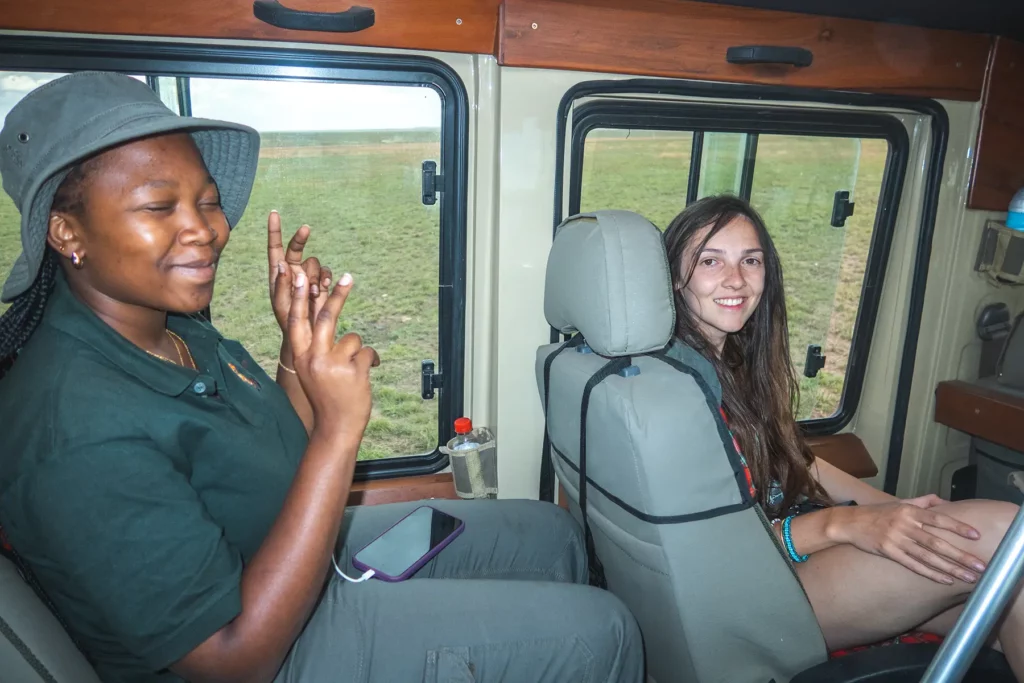
Option 3: International Travel Agents
Choosing an international travel agent is particularly appealing for those who value a seamless planning process and the reassurance that comes with booking through a well-established, globally recognised business.
International travel agents bring a global perspective to your Tanzania safari planning. They are adept at tailoring itineraries that not only include the safari experience in Tanzania but also integrate other elements of your trip, such as international flights, overnight stays in cities, and even connecting tours in neighbouring countries. This holistic approach ensures a stress-free travel experience from start to finish.

Whilst it may be reassuring to book through an international travel agency, the service that you receive when you arrive in Tanzania will be exactly the same as the service you’ll receive had you simply booked through a local tour operator. This is because international travel agents actually outsource the trips to local tour operators.
Despite this, booking with an international travel agency will always be more expensive than booking directly with local tour operators. This is because international travel agents have more overheads and often higher profit margins than local operators.
Additionally, international agents however may not have the same commitment to sustainable and responsible tourism practices as local operators, who often invest directly back into the communities and conservation efforts.
How to Book Your Safari with an International Travel Agent / Safari Company
- Comparison sites which provide multiple quotes from verified suppliers such as Safaris By Ella. When you select a luxury budget on the quote request, you will receive a quote from my recommended International safari company as well as my recommended local companies for comparison.
Join the rapidly growing tribe of over 1,000 travellers who’ve booked their dream safari using my insider tips and recommendations.
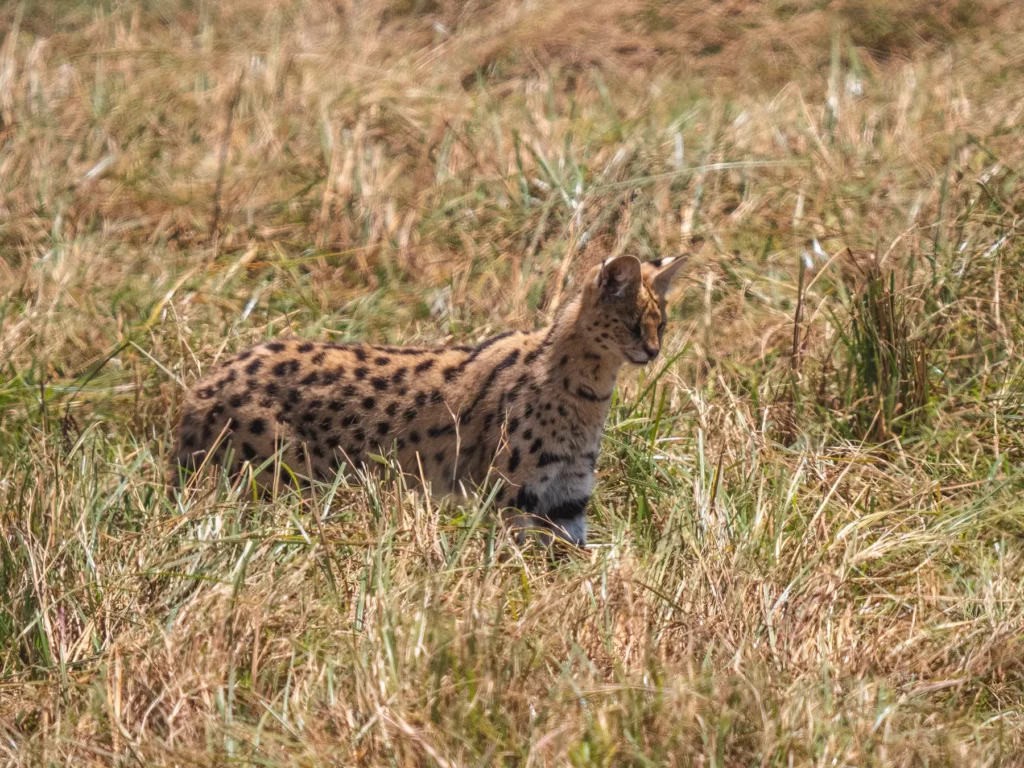
Option 4: Fly-In Hotel Safaris
Fly-in hotel safaris are the pinnacle of luxury and convenience on the Tanzanian safari scene, offering an exclusive gateway to some of the most remote and pristine areas of the country. This option is for those who wish to dip into the beauty of Tanzania’s landscapes and wildlife while ensconced in comfort and ease.
The essence of a fly-in safari is the swift and scenic journey to your destination. Departing from major cities, these small aircraft whisk you over some seriously breathtaking landscapes, offering aerial views of the plains, the Ngorongoro Crater, or the remote Selous Game Reserve. This not only saves time but also adds an unforgettable perspective to your safari experience.
Upon landing, you’re often greeted by the luxury lodge or camp staff and taken directly to your accommodation. These places are the epitome of safari chic, that blend eco-friendly design with high-end amenities.
With these types of safaris it’s the lodges themselves who organise the game drives for you. A big drawback of these types of safaris is you are often sharing your vehicle with other guests, which takes away the freedom that comes with a private safari. With shared safaris you have less say over which sightings you prioritise, how long you stay at each sighting and which part of the vehicle you are in. You may find yourself jostling with other guests for the best view!
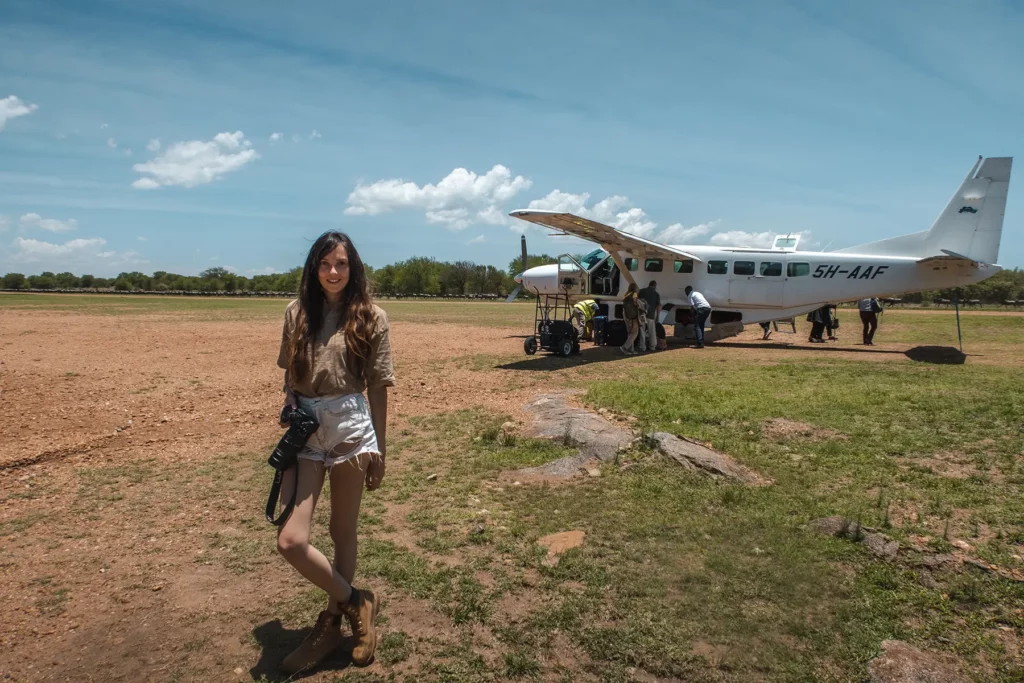
It’s also important to note that the fly-in hotel safari experience can feel somewhat isolated from the rawness and unpredictability of the African bush. The comfort and service, while impeccable, can create a buffer from the spirit that characterises more traditional safaris.
Opting for a fly-in hotel safari in Tanzania is about choosing the ultimate in luxury, convenience, and exclusivity.
It is however a significantly more expensive experience when compared with booking a driving safari with a local tour operator so is only suitable for travellers with higher budgets.
A good compromise may be booking a private safari with a local tour operator and opting to replace the longest legs of the journey with flights – something that local tour operators can arrange for you.
How to Book a Hotel-Provided Safari
- Option 1: My recommended tour operators on Safaris By Ella can arrange hotels and air or road transport to and from the hotels. If you opt for the more cost-effective road transport, since they have driven you to the hotel, you might find it cheaper to use the safari company for safaris rather than using the hotel-provided safaris.
- Option 2: Check with your chosen accommodation whether they provide this service and the booking requirements.

How Much Does a Tanzania Safari Cost?
A private Tanzania safari with a local tour operator starts at $300 per person per day for 2 adults. This price includes accommodation, airport transfers, transport throughout the safari, all meals, your driver guide, park fees, diesel and unlimited drinking water.
Shared safaris work-out slightly cheaper, starting at $180 per person per day. For this price you can expect budget camping accommodation.
For more information, I have an in-depth article on Tanzania safari costs.
Below you can view a chart of typical safari costs based on your budget.
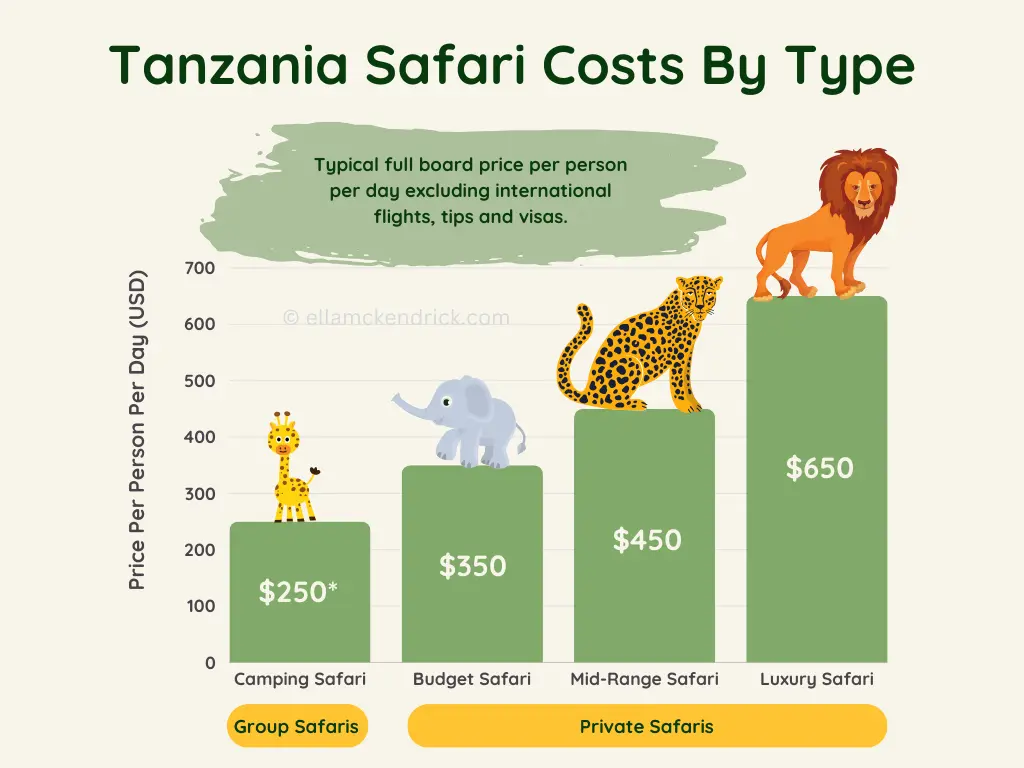
Please note that the costs above are for booking through a local operator. Prices will be quite a bit more if you book through an overseas company or travel agent.
Tanzania Safari Cost Breakdown
The bulk of the costs of the safari are in the park fees and accommodation.
For example, to visit the Serengeti you have to spend $70 + 18% tax per person per day plus an overnight concession fee of $60 + 18% tax per night. That’s $153.40 per person per day purely on park fees.
To visit Ngorongoro Crater you have to spend $70 + 18% tax per person per day plus a vehicle fee of $299 + 18% tax. For 2 people that’s $259 per person per day on park fees.
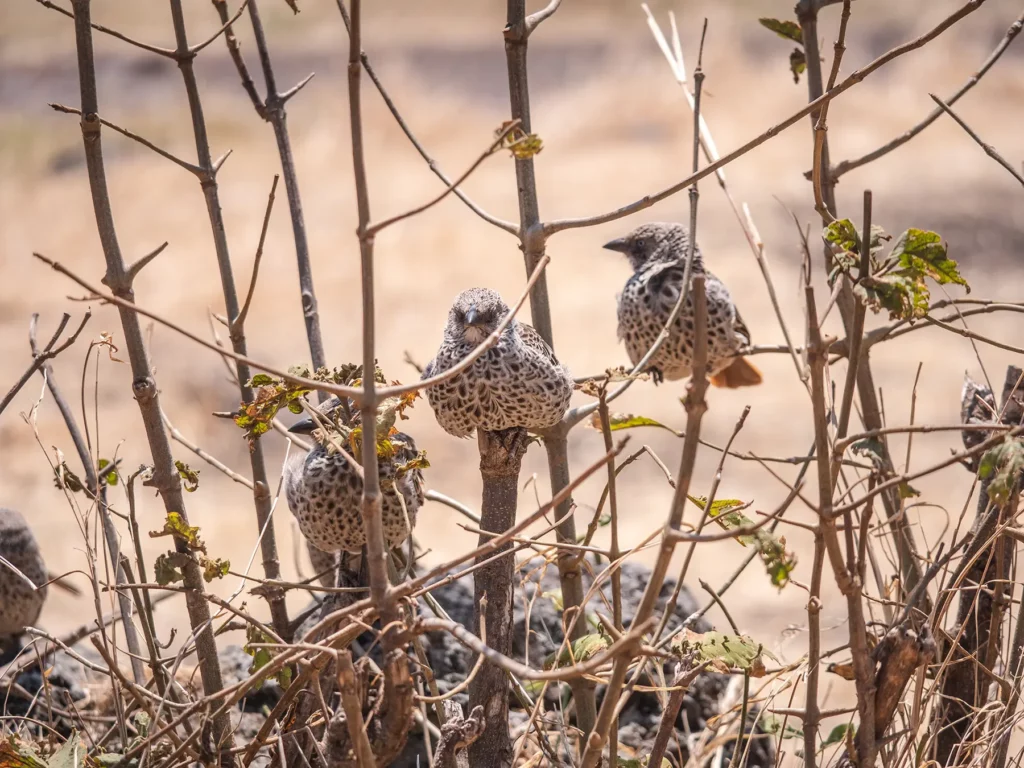
Accommodation prices can vary wildly, from budget accommodations outside of parks costing around $30 per person per night to luxury lodges costing in excess of $1,000 per person per night.
If you want to visit the Serengeti then sleeping within the national park is the only option. Tented camps within the Serengeti start at $100 per person per night (excluding concession fees).
Below I’ve included a chart which breaks down where the money goes for a safari of 2 people.

Factors Affecting Tanzania Safari Cost
One of the biggest factors that will affect your safari cost is how many people are in your group.
If you’re travelling with a larger group of people, your safari cost will be cheaper than if you’re travelling as a couple. Safaris are in contrast the most expensive for solo travellers.
This is because there are some fixed costs involved in your safari (such as vehicle costs, diesel, vehicle park fees and your driver guide) which are the same no matter how many people are in your group. These costs are split amongst all participants on the safari.
Effect of group size on safari vehicle cost per person
| Party size | Truck contribution per person | Group size savings per person |
| 1 | $250.00 | $0.00 |
| 2 | $125.00 | $125.00 |
| 3 | $83.33 | $41.67 |
| 4 | $62.50 | $20.83 |
| 5 | $50.00 | $12.50 |
| 6 | $41.67 | $8.33 |
| 7 | $35.71 | $5.95 |
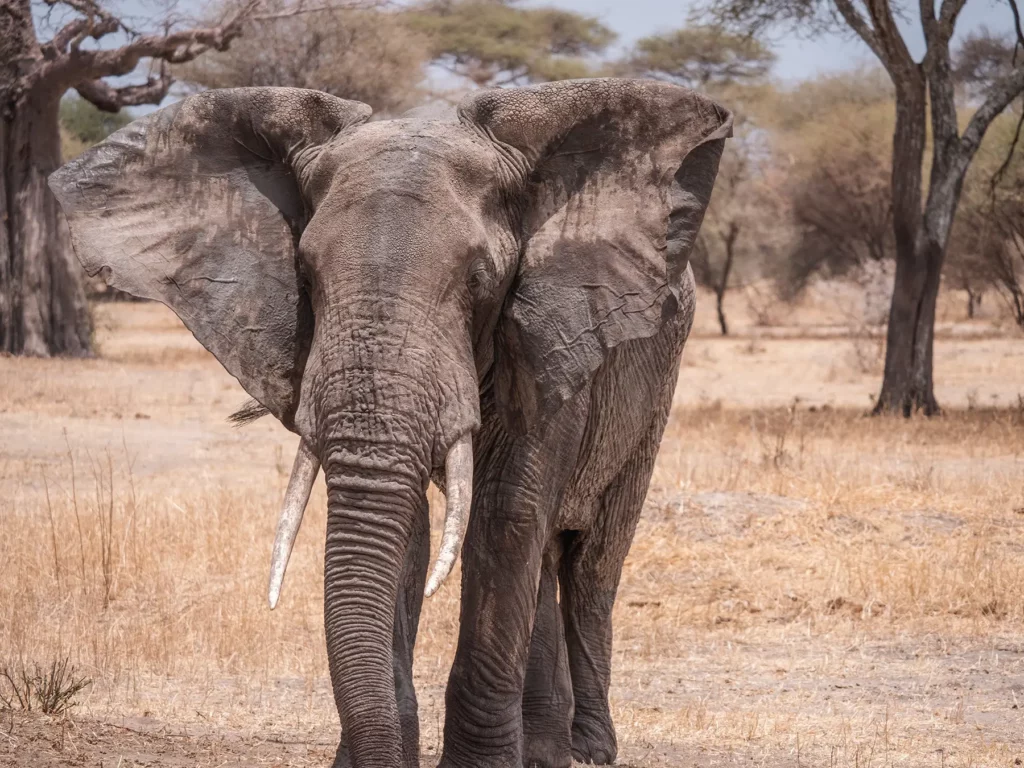
I’ve mentioned above that a private safari starts at $300 per person per day for a group of 2 people. That same private safari starts at $500 per person for a solo traveller.
Another factor that can significantly impact the cost of your safari is which parks you visit. The Serengeti and Ngorongoro are the most expensive parks so an itinerary which includes these will cost more than an itinerary that just visits budget parks like Lake Manyara and Arusha National Park.
Finally, your accommodation choice greatly affects the cost of your Tanzania safari. A safari where you stay at budget accommodation can be between $300 and $400 per day, a mid-range safari is $400 to $600 per person per day and a luxury safari starts at $600 per person per day.
You can read my Tanzania safari costs guide to learn more about and how to get the most bang for your buck.
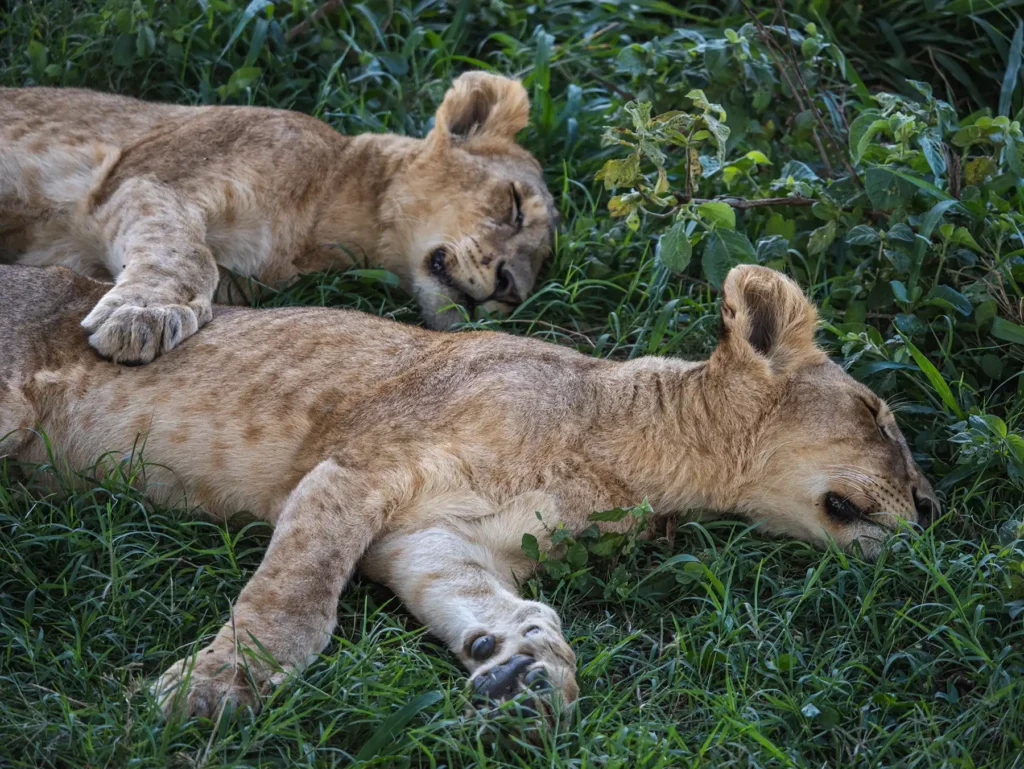
Best Time to Go on Safari in Tanzania
Deciding on the best time to go on a safari in Tanzania is an important part of ensuring an unforgettable journey. This East African gem offers diverse landscapes and wildlife spectacles throughout the year, making almost any time a good time to visit. Understanding the nuances of Tanzania’s seasons and how they influence wildlife behaviour can help you choose the perfect time of year for your safari adventure.
The dry season, spanning from June to October, is widely regarded as the prime time for wildlife viewing in Tanzania. As water sources become scarce, animals congregate around rivers and waterholes, lining you up for some incredible shots and the vegetation is sparse, improving visibility.
This period also coincides with the Great Wildebeest Migration’s dramatic river crossings in the Serengeti, a spectacle that draws many tourists from around the globe. The sight of thousands of wildebeest and zebras braving crocodile-infested waters is both awe-inspiring and heart-wrenching.
However, the dry season’s popularity means higher prices and more crowded parks. Booking well in advance is crucial to secure your spot in this peak safari season.

I’ve ranked each month of the year for safari in Tanzania as Excellent, Good, OK, or Poor, based on typical game viewing and weather conditions.
If you want to dig deeper, the chart below shows what you can expect in each month in Tanzania in terms of cost, weather, wildlife and hiking Kilimanjaro.
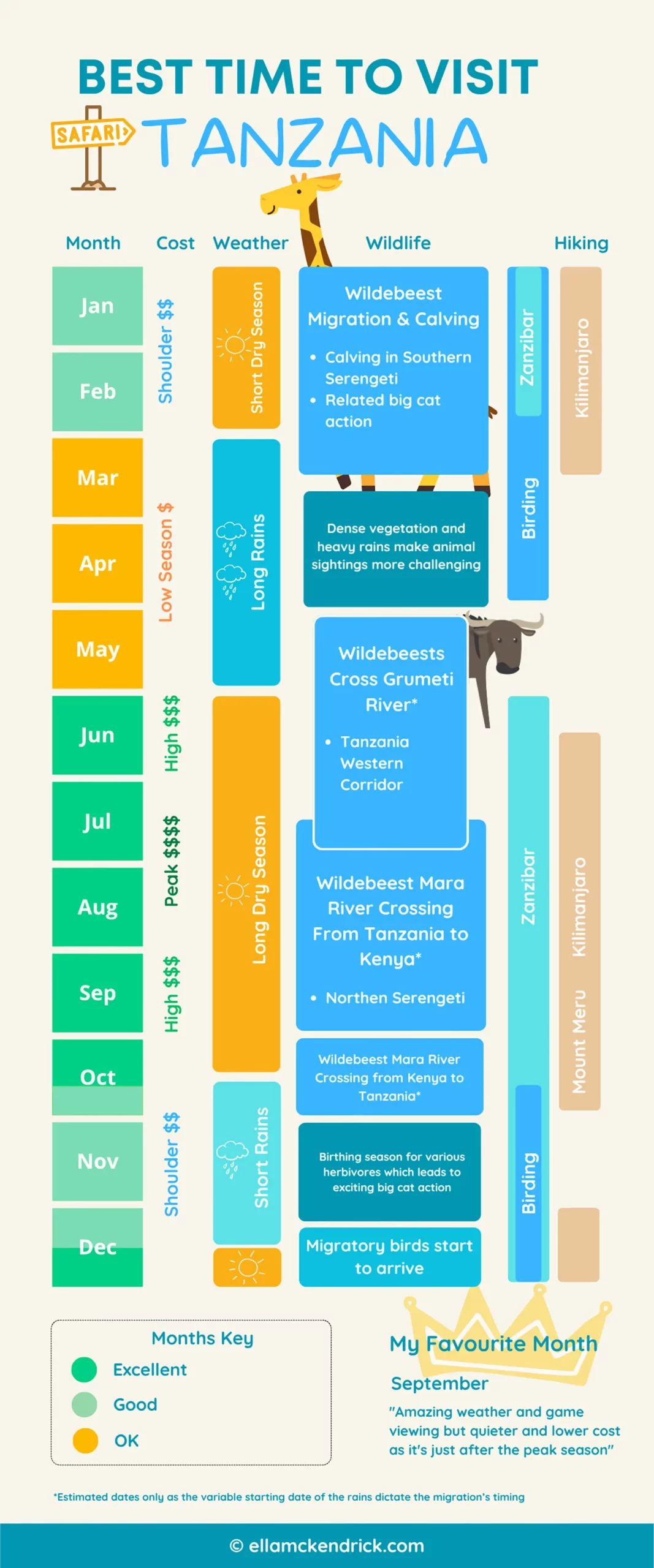
For more information take a look at my ultimate guide on the Best Time to Visit Tanzania.
The wet season, divided into the short rains (November to December) and the long rains (March to May), transforms the landscape into a green paradise. This is the time for bird watchers and photography enthusiasts to visit, as the parks are alive with vibrant colours and the skies are clear and dust-free.
The wet season is also the birthing period for many animals, offering the amazing opportunity to witness the beginning of life in the wild. Predatory action is at its peak as well, with predators taking advantage of the abundance of young and vulnerable prey – you have been warned!
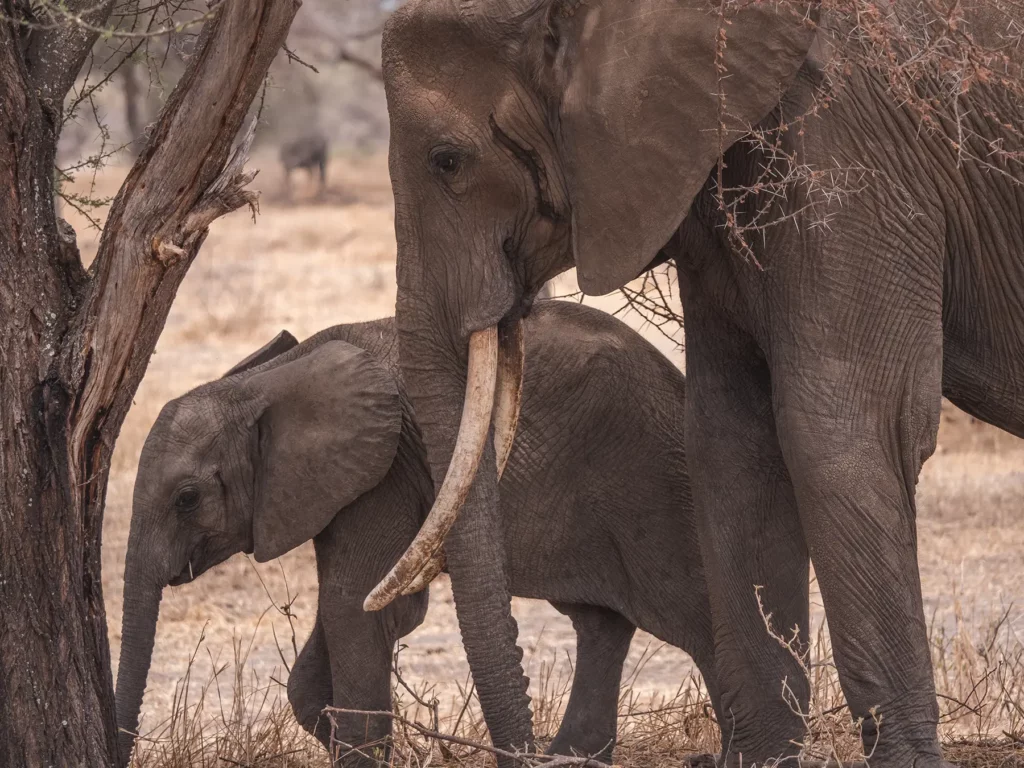
While some areas may be less accessible due to the rains, and certain lodges may close during the heaviest downpours in April and May, the wet season offers the advantage of lower prices and fewer tourists, providing a more exclusive and intimate safari experience.
The months transitioning between the dry and wet seasons (January, February, and June) can offer the best of both worlds. The weather is generally good, with fewer crowds than the peak season and a landscape that is gradually shifting from green to gold. These months are particularly good for spotting predators and enjoying the calmer atmosphere of the parks before or after the high season rush.
Ultimately, the best time to go on safari in Tanzania depends on what you want to see and experience. No matter when you decide to go, Tanzania’s wilderness and wildlife promises an unforgettable safari adventure, with each season offering its own unique magic that I have fallen in love with time and time again.
For more information, you can read my guide on the perfect time of the year to visit Tanzania.

How Long to Spend in Tanzania
The length of your stay is a big decider on what you’re able to see and do on your Tanzania adventure. Whether you have a long weekend and thus are only looking for a 3-day itinerary, or you have 5 days to enjoy a safari, there’s an itinerary to match your timeline, letting you make the most of your time in the country.
However, in order to get the most out of your trip, I’d say 7-10 days is the minimum amount of time to spend on safari in Tanzania. For an even more immersive experience, where you are exploring in your own time, 2 weeks is a fantastic amount of time.
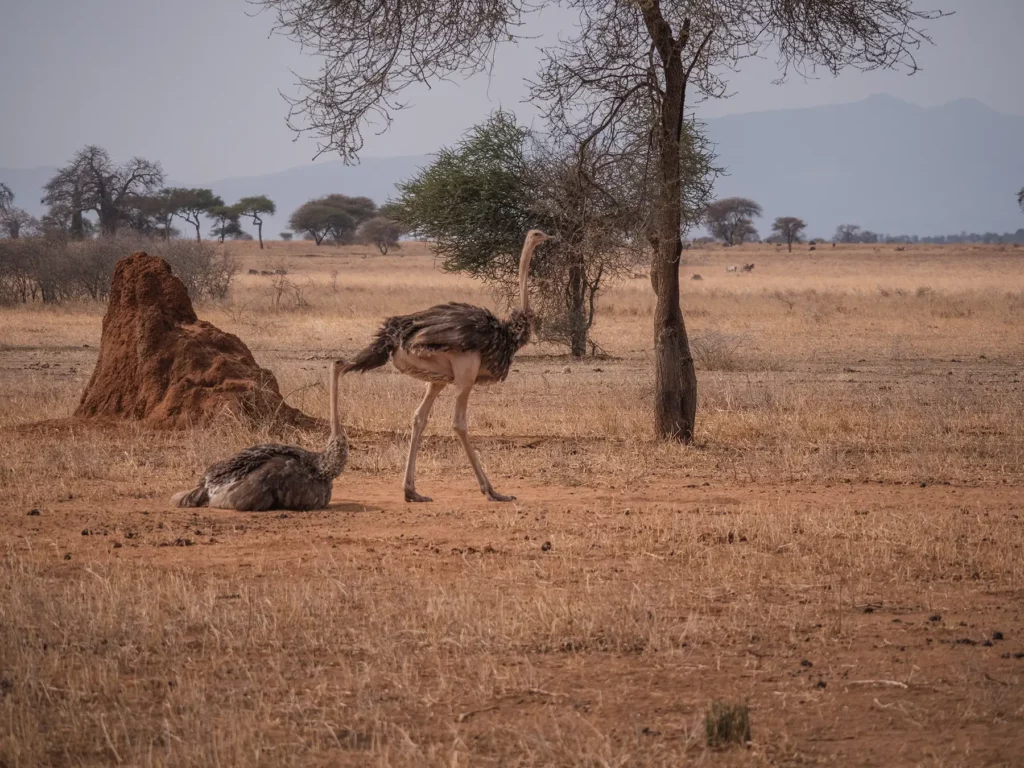
Tanzania Safari Logistics
Going on a safari in Tanzania will always need a little preparation and an understanding of the essential logistics. From obtaining the right travel documents to ensuring your health and safety, I will guide you through the key steps to make your journey as smooth as possible.
Visas
For most countries including the UK, US, Australia and many countries in Europe, entering Tanzania requires a visa, which can be obtained either before departure or upon arrival.
A tourist visa typically allows for a stay of up to 90 days, giving you ample time to explore Tanzania.
For the majority of countries, a single entry visa which costs $50 per person is required. However for US citizens, you will need a multiple entry visa which costs $100 per person.
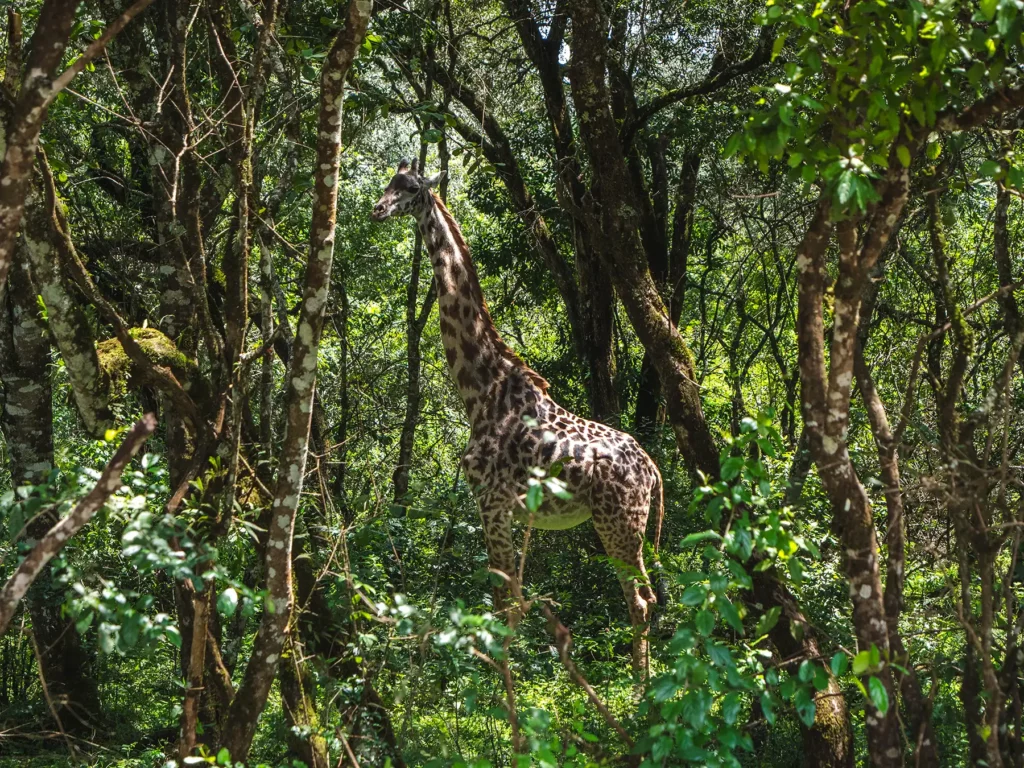
To avoid any potential delays or complications, it’s definitely advisable to secure your visa ahead of time through the official e-visa website. It can take a week or two for your visa to get approved so I’d recommend applying for your visa 1 or 2 months in advance of your flight to Tanzania.
Ensure your passport has at least six months’ validity from your date of entry and at least one blank page for stamps.
Vaccinations
Before jetting off to Tanzania, it’s really important to be up-to-date with vaccinations. It’s recommended that you visit a travel health clinic or your GP at least 8 weeks before your departure. You can view an up-to-date list of recommended vaccinations here.
There are no mandatory vaccines for visiting Tanzania unless you have recently visited a Yellow Fever country, in which case you would need to have a Yellow Fever vaccine and would be required to bring your yellow fever vaccination card with you. Kenya and Uganda are both countries that have a risk of Yellow Fever transmission so you will need to get vaccinated if your trip also visits these countries.
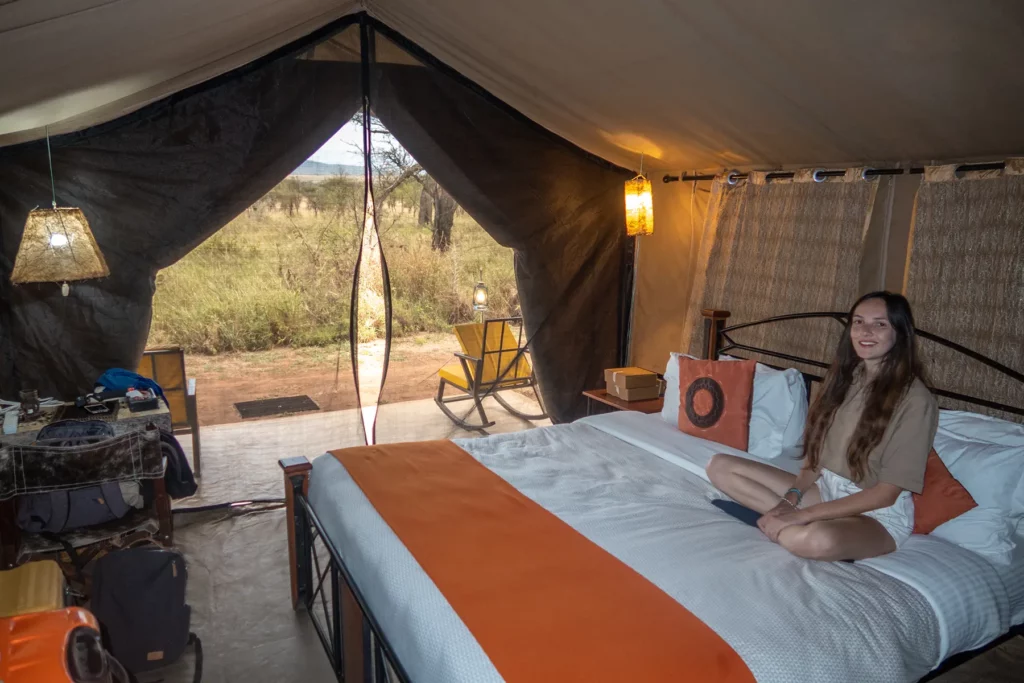
Medication
Malaria is prevalent in Tanzania, so definitely discuss antimalarial medication with your healthcare provider. There are a number of antimalarial options available and exactly which you take depends on the recommendations of your doctor.
In addition to antimalarial medication, I always recommend to prepare a travel health kit containing any prescription medications you’re currently taking, as well as over-the-counter drugs for the usual travel-related ailments like diarrhoea, pain, and allergies. Ensure your prescriptions are clearly labelled and, if possible, carry a letter from your GP detailing your medications and why you need them.
Oh!, and don’t forget to include insect repellent, sunscreen, and, because you all know my accident prone-ness, a basic first aid kit.
Save time and ensure an incredible safari experience
Get quotes from the local tour companies I use to organise my own trips.
You’ll join the rapidly growing tribe of over 1,000 travellers who’ve booked their dream safari using my insider tips and recommendations.
2-Week Tanzania & Zanzibar Safari Overview
Below I’ve crafted the perfect 2-week Tanzania safari & beach itinerary, based on my own personal experiences in Tanzania as well as spending countless hours researching the topic and talking to local Tanzanian guides.
On this trip, you’ll be jumping headfirst into the buzz of Arusha, a lively town that’s your gateway to the safari of a lifetime. It’s where you shake off the jet lag, grab those last-minute essentials you forgot to pack, and get your first taste of Tanzanian hospitality.
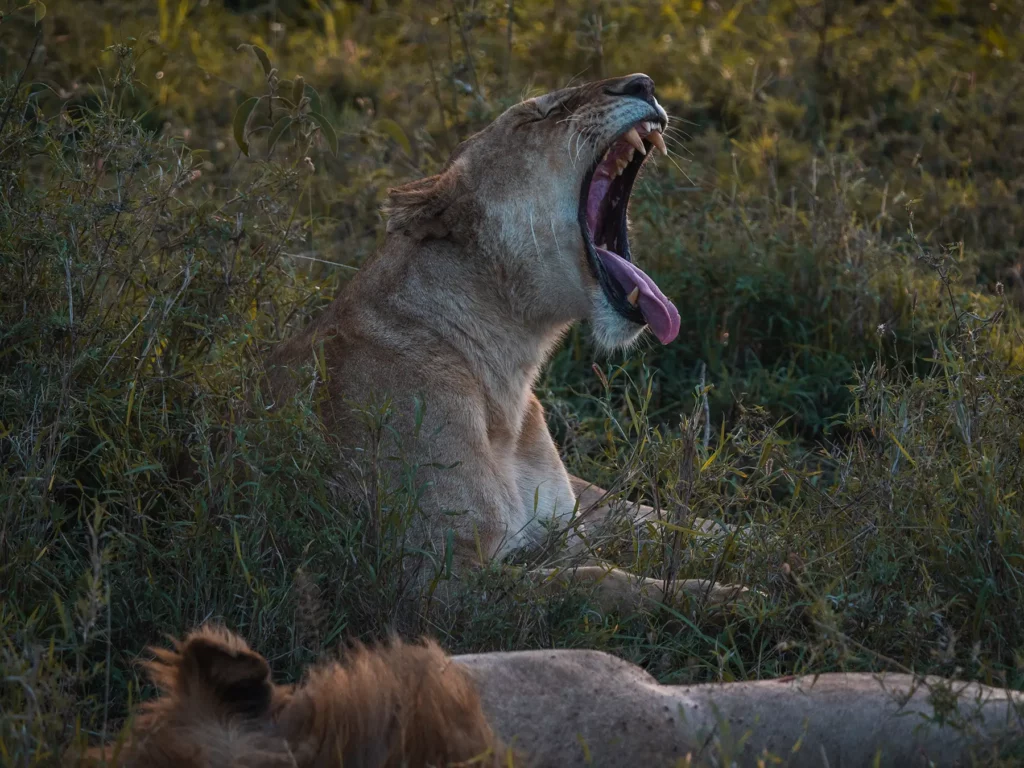
Then, with your safari hat on and camera at the ready, you venture into the wild. Prepare to be blown away by the huge herds of elephants in Tarangire National Park. You’ll then feel as though you’ve stepped back in time as you pay a visit to some of Tanzania’s 120 tribes. And just when you think you’ve seen it all, you visit the Ngorongoro Crater, with its Eden-like vibe with a side of rhino sightings and picnics next to hippos.

Perhaps the highlight of the itinerary is the mighty Serengeti. The Serengeti doesn’t just live up to its postcard fame; it blows it out of the water. It’s all about the thrill of the chase here, following the hooves of the wildebeest migration, and spying on big cats doing their thing.
But it’s not all about bouncing around in a 4×4. After your safari fix, head to Zanzibar, where the pace shifts from lion chases to lazy beach days. This spice island is a cocktail of cultures, history, and some of the bluest waters you’ve ever seen. It’s where you learn to slow down, savour the moment, and maybe get a little better at haggling in Stone Town’s maze-like markets.

Click any of the days below to jump to my full notes on that day.
Day 2: Tarangire National Park
Day 3: Tarangire National Park
Day 4: Lake Manyara National Park
Day 6: Hadzabe & Datoga Tribes
Day by Day Breakdown of the Ultimate 2-Week Tanzania & Zanzibar Safari Itinerary
Day 1: Arusha
Total drive time (excluding game drives): 45 minutes from Kilimanjaro International Airport to Arusha. Exact driving time depends on the activities you do today
Your adventure in Tanzania can start the moment you land, depending on the timing of your flight.
Early arrivals offer the perfect opportunity to dive straight into the heart of Tanzania with a visit to some of the local attractions or a leisurely day at your hotel, acclimatising to the beauty of Africa. For those arriving later, the evening can be spent settling into your accommodation, with the promise of adventure waiting for you at dawn.
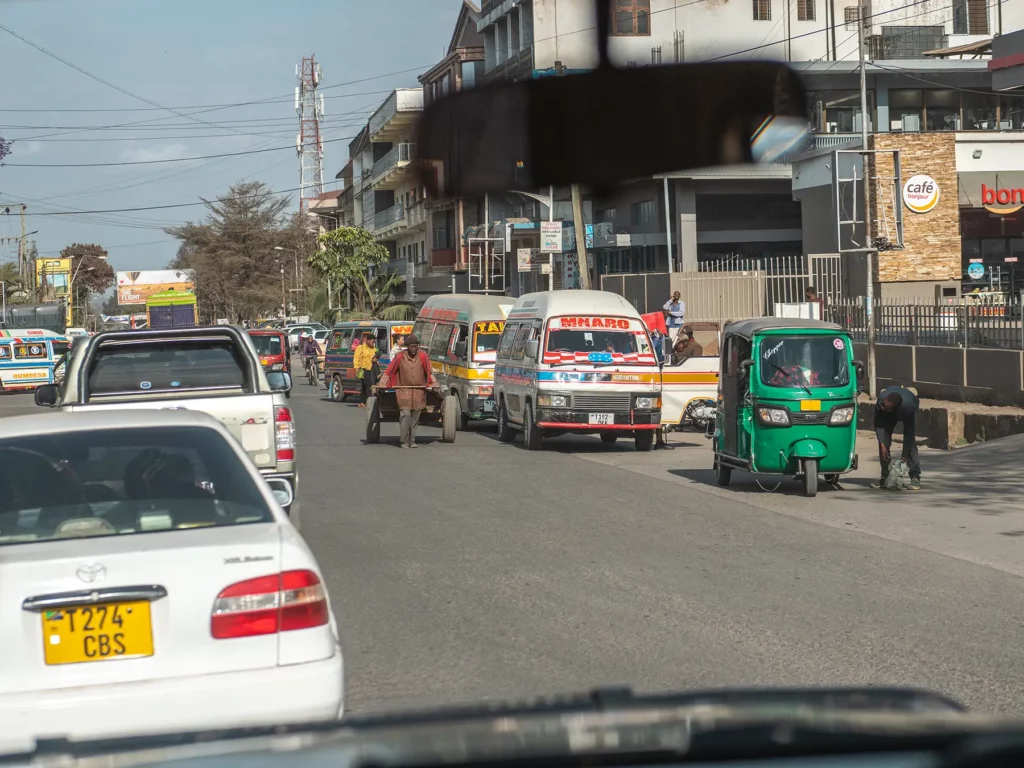
About Arusha
Arusha, often dubbed the safari capital of Tanzania, is more than just a gateway to the northern safari circuit; it’s a place brimming with a bustling market scene.
Nestled at the foot of Mount Meru, Arusha offers a cooler climate and an environment that makes it the perfect starting point for your Tanzanian adventure. Its strategic location provides easy access to Tanzania’s top safari destinations, including the Serengeti, Ngorongoro Crater, and Kilimanjaro National Park.
Where to Spend the Night
Arusha boasts a wide range of accommodation options to suit every traveller, from luxury lodges to cosy guesthouses. For those seeking comfort and a bit of elegance, the Arusha Coffee Lodge offers a retreat amidst the aroma of coffee plantations.
Budget-conscious travellers might prefer the atmosphere of the Green Mountain Hotel, known for its friendly service and excellent location.
Choosing the right place to rest your head will ensure you’re well-rested and ready for the days ahead.
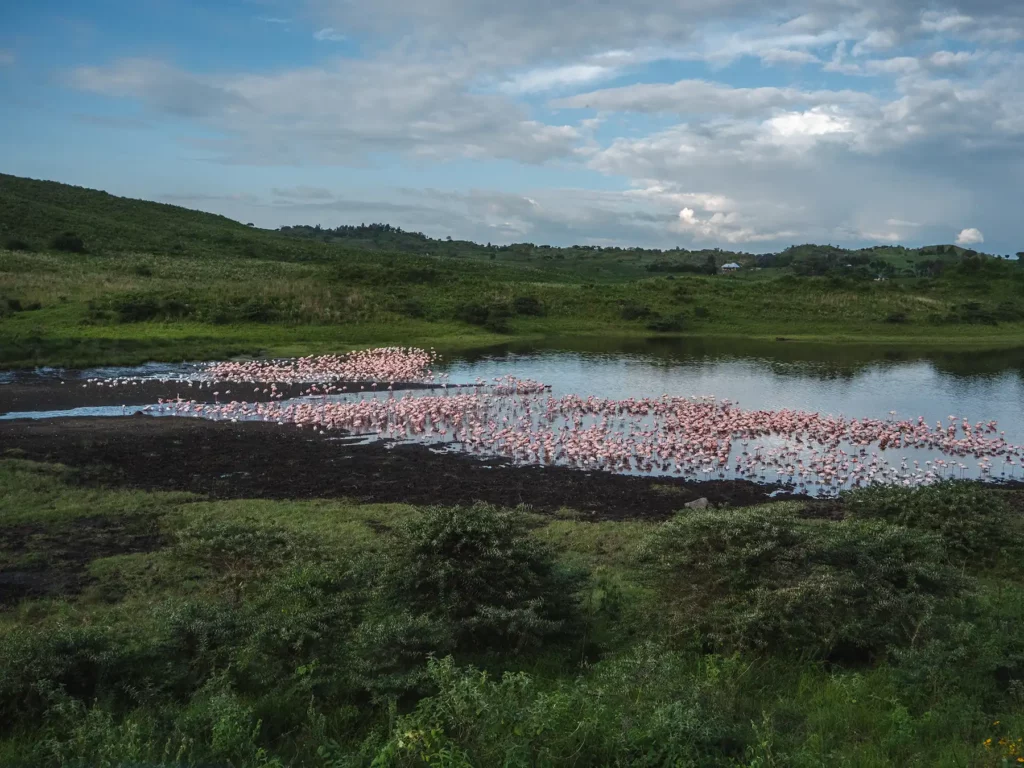
Things to Do in Arusha
Arusha is a treasure trove of activities, offering something for every type of traveller. From exploring Arusha National Park to bargaining for souvenirs at local markets, your time in Arusha can be as laid-back or as adventurous as you wish.
Here are some of my favourite things to do!
1. Arusha National Park
Just a short drive from the city, Arusha National Park is a must-visit for nature lovers. This park features a diverse range of habitats, from the alkaline Momella Lakes, home to flamingos, to the dense montane forests inhabited by colobus monkeys. You can enjoy a safari, a canoe trip on the lakes, or you could even arrive a couple of days before your safari and hike to the summit of Mount Meru.
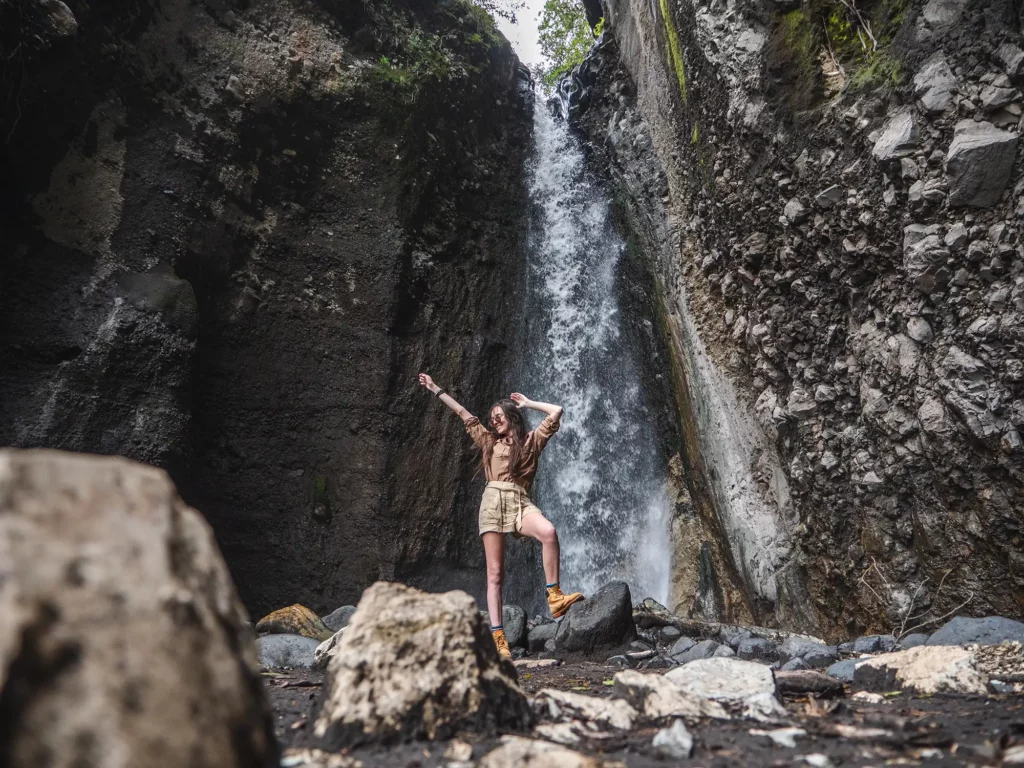
2. Local Markets
The Central Market will provide you with one of those ‘wow’ moments. It’s a busy hub where you can find everything from fresh produce to handmade crafts. It’s an excellent place for those looking to experience the local way of life and pick up some unique souvenirs.
3. Chemka Hot Springs
Tucked away a short drive from the hustle of Arusha, Chemka Hot Springs is like stumbling upon a little secret. This isn’t just any watering hole; it’s a natural jacuzzi set in the heart of Tanzania, offering a slice of paradise that feels miles away from the safari dust and the everyday rush.
Chemka Hot Springs are two turquoise lagoons fringed by lazy palm trees. They are connected by a narrow canal and provide the perfect dose of relaxation. The springs are not quite as hot as the name suggests but are more lukewarm.
Getting there is half the fun, with roads that snake through Tanzania’s landscapes, offering peeks of rural life and the kind of scenery that makes you press your nose to the window.
Chemka is nature’s own spa, minus the hefty price tag (only $5 per person) and with the added bonus of a soundtrack provided by the surrounding wilderness. You can enter the springs via some steps or leap into them on a rope swing. Rubber rings are available to rent for an extra fee.

4. Eat at One of Arusha’s Delicious Restaurants
Arusha’s culinary scene really is as diverse as its landscape. For a taste of local cuisine, visit the Khan’s BBQ for its legendary chicken tikka.
The Blue Heron Restaurant, set in a beautiful garden, offers a mix of international and Tanzanian dishes, perfect for a relaxed meal spent discussing the rest of your travel plans.
Tips for Visiting Arusha
Spending some time in Arusha before your safari gives your body some time to acclimatise – to relax and shake off any jetlag.
Arusha is where worlds collide, and walking its streets with respect can turn everything you do into a learning moment. Whether it’s understanding the nuances of a Maasai greeting or appreciating the artistry of a local craftsperson, showing that you value these cultural treasures will make your journey so much more meaningful.
Safety-wise, Arusha’s pretty safe, but that doesn’t mean you should leave your common sense at the airport. Like any city, it’s smart to keep your wits about you, particularly after dark or in crowded spaces. A little caution goes a long way in ensuring your adventures are memorable for all the right reasons.
And while it’s tempting to see Arusha merely as a gateway to Tanzania’s wilder side, this city can be an adventure in its own right. It’s the perfect launchpad for safari excursions into the Serengeti or trips to the Ngorongoro Crater, but Arusha’s own streets, markets, and hidden gems are waiting to be explored.
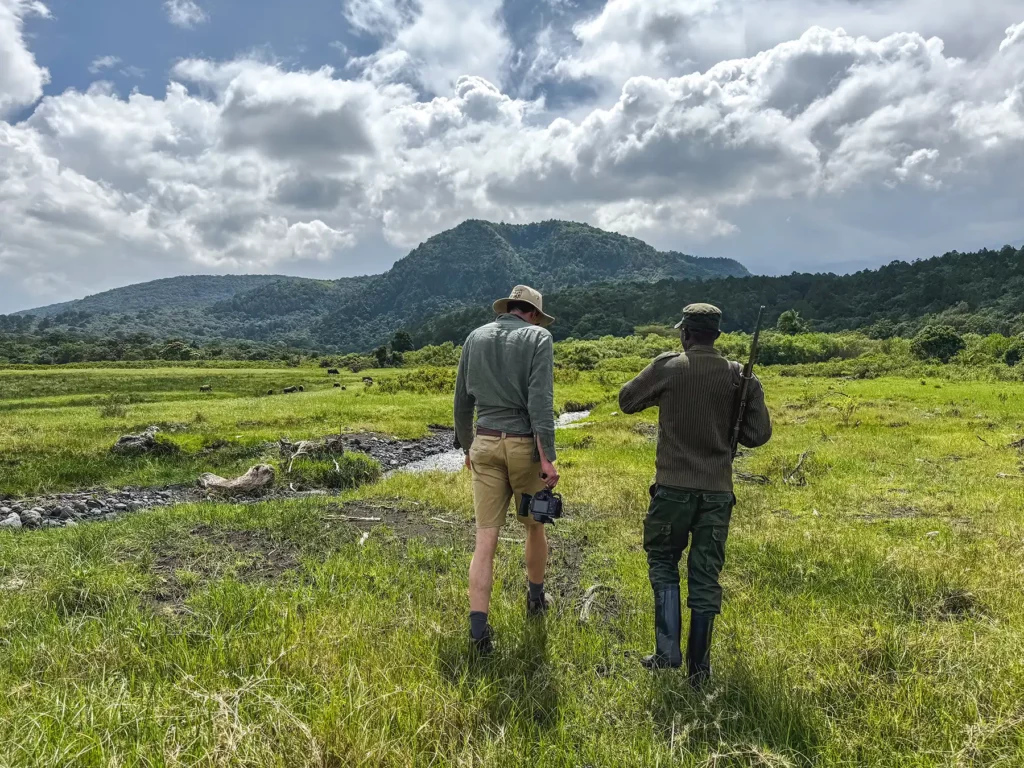
My Experience Visiting Arusha
I’ve passed through Arusha a number of times now and have grown fond of the energetic town. Personally I think it’s well worth spending at least a day here and embark on one of the many day trips that you can enjoy from Arusha.
Arusha National Park perhaps provided me with my favourite experience. I was pleasantly surprised by this park, expecting it to be void of life considering that most travellers chose to skip it. In fact I found the lush jungle foliage to be a welcome change from Tanzania’s open plains and enjoyed seeing some new and exciting species here such as the colobus and blue monkeys. You can also embark on a walking safari here, something that you can only do in a handful of Tanzania’s national parks. Seeing huge animals like giraffes or buffalos on foot provides a novel experience.
You can watch a video my Arusha experience below.
Day 2: Tarangire National Park
Total drive time (excluding game drives): 3 hours
Today you will drive from Arusha to Tarangire National Park.
The journey will show you some of the many landscapes of Tanzania, leading you to a world-renowned haven for elephant enthusiasts and bird watchers alike.
Your first proper day of safari is dedicated to exploring the vastness of Tarangire, renowned for its large elephant herds, baobab trees, and the Tarangire River, which acts as a magnet for wildlife during the dry season.

Itinerary
Begin your day with an early departure from Arusha, allowing the morning air to accompany you as you head towards Tarangire National Park. The drive will take around 3 hours.
Upon arrival, set off on a full-day game drive. The landscapes here are incredibly varied, with grassy savannas, swamps, and the river itself providing a lifeline for the animals. As the day unfolds, witness large herds of elephants, along with giraffes, buffaloes, and, if you’re lucky, a glimpse of the elusive leopard.
After a day filled with wildlife sightings, retire to your accommodation just outside the park, where the sounds of the African bush will serenade you under a starlit sky.
About Tarangire National Park
Tarangire National Park is Tanzania’s sixth-largest national park and a sanctuary for an impressively large elephant population.
During the dry season, the Tarangire River is the only source of water in the area, drawing an incredible concentration of wildlife, making it one of the best places in Tanzania to see elephants up close.
The park is also home to over 300 bird species, from the lilac-breasted roller to the martial eagle.
Where to Spend the Night
After a day of adventure, relax at one of the many lodges or tented camps within or just outside Tarangire National Park.
Options range from luxury lodges like Tarangire Treetops, where rooms are perched on platforms among the baobab trees, to more budget-friendly tented camps like Tarangire Safari Lodge, offering comfortable accommodations with stunning views over the park.
These stays provide the perfect blend of comfort and nature, allowing you to unwind to the sounds of the wilderness.
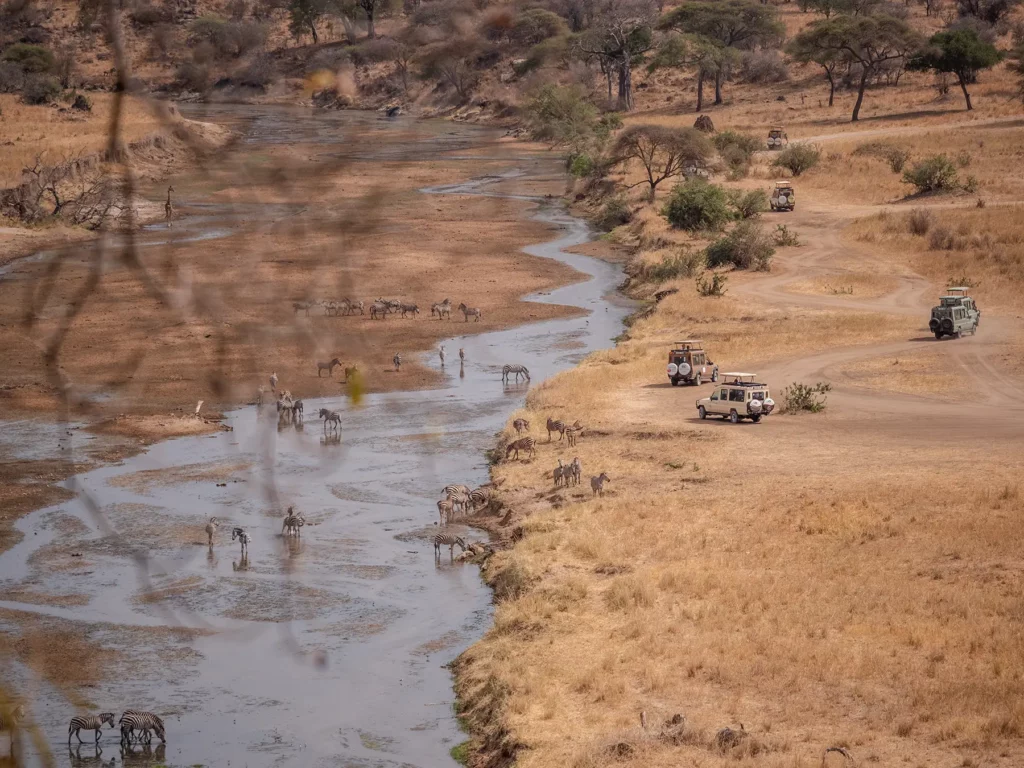
Tips for Visiting Tarangire National Park
As with any safari, remember to protect yourself from the sun. Wear a floppy sun hat or cap to protect your head, sunglasses and cover yourself in sunscreen. I always keep my sunscreen with me on game drives so I can reapply as necessary throughout the day.
The landscapes, the wildlife—it’s like the whole park is posing just for you. But remember, a dead camera is no good to anyone, so charge those batteries before your safari and make sure you have enough space on your memory card. There’s nothing worse than spotting the perfect shot only to see that dreaded “memory full” message.
My Experience Visiting Tarangire National Park
Tarangire National Park will always hold a special place in my heart as it is the first place that I went on safari where I truly felt wowed.
After seeing more elephants than I can count (including a young calf rolling around in the water!), baby baboons frolicking about and even a group of four lions, I left proclaiming that Tarangire provided me with the best safari experience that I’d ever had.
Little did I know, my next destinations, Ngorongoro and Serengeti were about to rival my experience here, believe it or not.
Tarangire is quite frankly an elephant lover’s dream. The herds here are sometimes as large as 300 members strong, and trust me, seeing that many elephants strolling through the long yellow grass is a sight that will stay with you for a lifetime.
The terrain in Tarangire is vastly different from the Serengeti or Ngorongoro. The vegetation is dense here and the grass is long. It’s very beautiful, in my opinion, especially the slightly funny-looking baobab trees.
You can watch a video my Tarangire experience below.
Day 3: Tarangire National Park
Total drive time (excluding game drives): 0 hours
Today you have the full day to enjoy the beauty of Tarangire National Park, increasing your chances of seeing all of the park’s delightful residents.
Itinerary
Today you will spend the full day on safari in Tarangire National Park.
Your day in Tarangire is going to be chock-full of wildlife spotting. We’re talking a full-day game drive that gets you up close and personal with some of Africa’s most iconic animals. Elephants? Check. Lions? You bet. And let’s not forget the giraffes, zebras, and a whole host of bird species.
Tarangire is a bit of an unsung hero when it comes to birdwatching, so even if you’re not a bird nerd, you’re about to become one.
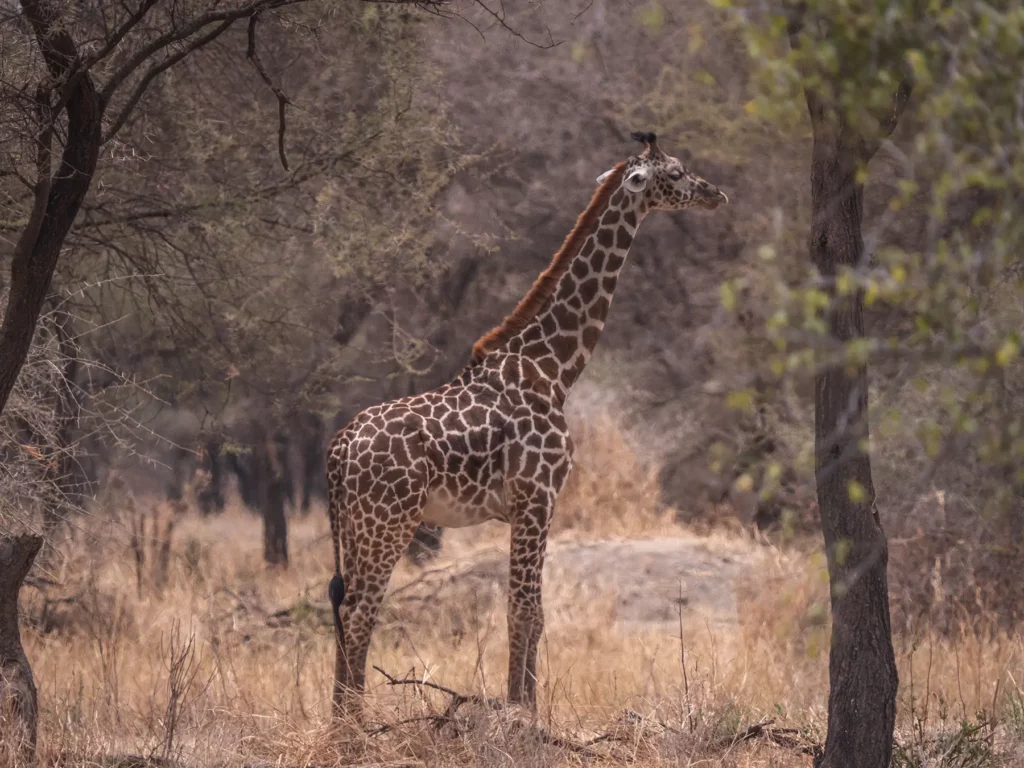
You’ll break-up your safari with a picnic lunch at a scenic lunch spot overlooking the Tarangire River.
As the afternoon starts to cool down, head out of the park and make your way to the lively town of Mto Wa Mbu. This drive is a little adventure of its own, offering glimpses of rural life and the stunning landscapes that make Tanzania such a knockout.
You’ll spend the night in the lush town of Mto Wa Mbu.
Where to Spend the Night
After a day filled with adventure in Tarangire, spend your night in the town of Mto Wa Mbu or just outside it. This place is a little town that’s as energetic as it is welcoming.
You’ve got options here for a good night’s sleep, from lodges that offer a comfy bed and a hot shower to more upscale tented camps where you can listen to the sounds of the African night.
It’s the perfect spot to unwind, maybe swap stories with fellow travellers, and gear up for the next leg of your safari journey.
Tips for Your Morning Safari in Tarangire National Park
The early bird catches the worm, or in this case, the early safari-goer catches the lion, elephant, or maybe even the elusive leopard in action. It’s the cool of the morning when the animals are most active, so set your alarm, and get out there before the sun climbs too high. Trust me, there’s nothing quite like watching the savannah come to life as the day begins.
Temperatures can fluctuate quite dramatically during the day so I’d recommend layering up so that you’re ready for all temperatures. I like to wear a vest top covered by a long-sleeved shirt covered by a jumper. As the sun starts to rise and the day becomes warmer, I can then take layers off accordingly.
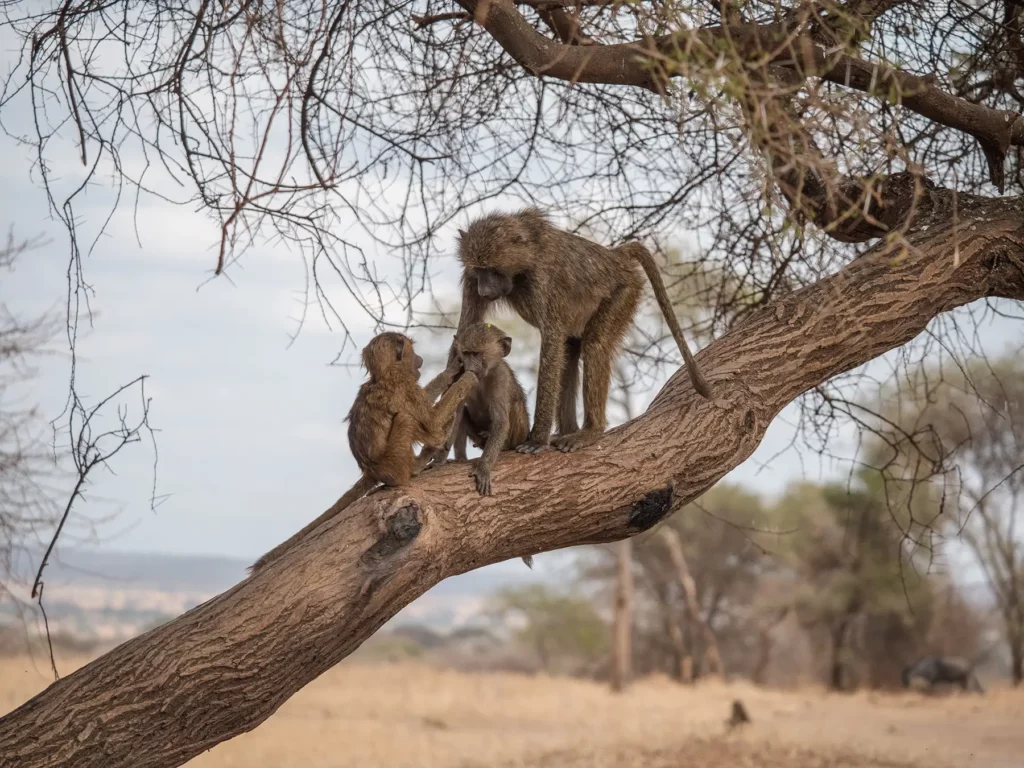
Day 4: Lake Manyara National Park
Total drive time (excluding game drives): 3 hours
Day four of your Tanzanian safari brings you to the scenic Lake Manyara National Park, nestled at the base of the Rift Valley escarpment.
Known for its alkaline soda lake, dense woodlands and steep mountainsides, Lake Manyara offers a unique safari experience, with excellent opportunities for birdwatching and spotting tree-climbing lions.
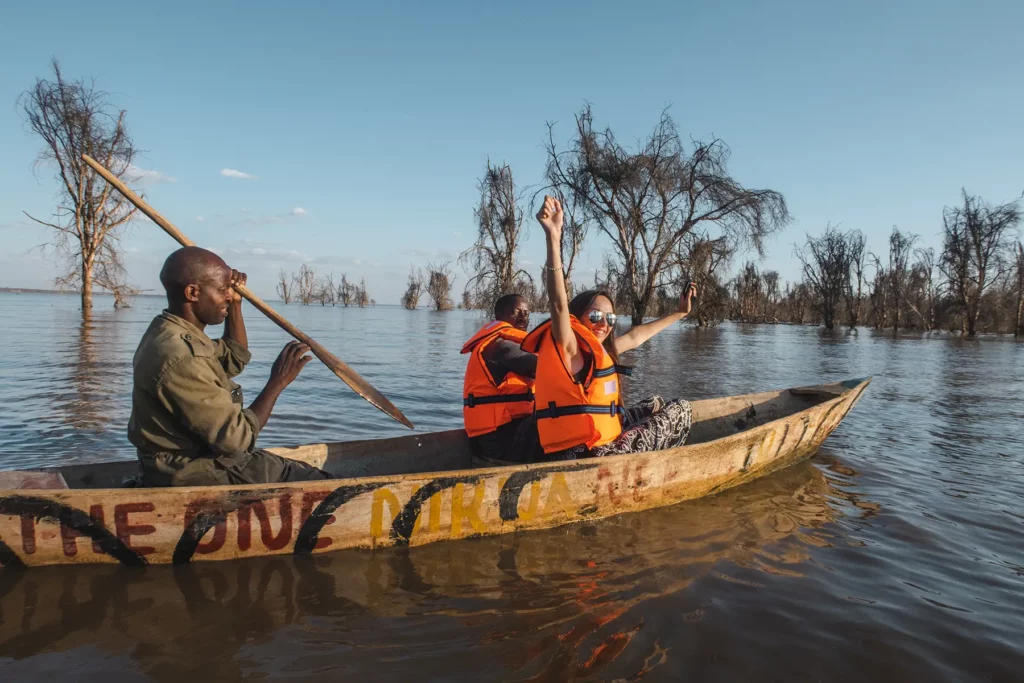
Itinerary
Start your day with an early morning game drive in Lake Manyara National Park, where the golden sunrise illuminates a landscape teeming with wildlife.
The park’s compact size makes it ideal for a half-day exploration, ensuring you get to see its beauty without haste.
After a picnic lunch at a scenic lunch spot within the park, you’ll leave Lake Manyara and start on your journey to Lake Natron, an adventure that introduces you to some of Tanzania’s most dramatic landscapes, transitioning from lush greenery to the stark, otherworldly beauty of the Rift Valley.
You’ll spend the night on the banks of Lake Natron.
About Lake Manyara National Park
Lake Manyara National Park is a small but spectacular park that spans different habitats, offering sanctuary to over 400 bird species. The park is also famed for its tree-climbing lions, a unique behaviour not commonly observed in other lion populations.
Large troops of baboons, elephants, and hippos add to the park’s wildlife spectacle.
Unfortunately in recent years Lake Manyara National Park has been shrinking. The rising water levels from Lake Manyara have flooded vast swathes of forest, killing off countless trees and forcing much of Lake Manyara’s residents to vacate. As a result, Lake Manyara isn’t as full of life as it once was. Once a paradise for elephants, they are now not as common to come across.
Despite this, Lake Manyara is still worth visiting. The tropical forests make it a very unique park and one of the best places in Tanzania to see primates such as baboons. It’s also great for bird lovers.
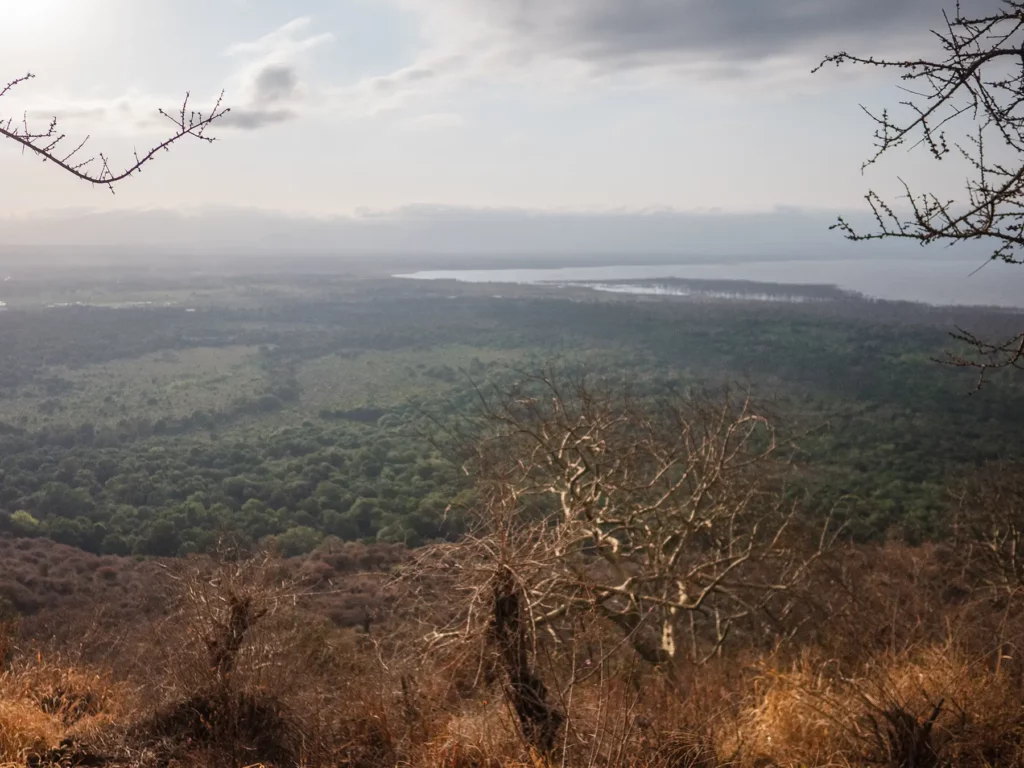
Where to Spend the Night
After exploring Lake Manyara, continue to Lake Natron for an overnight stay. The area around Lake Natron offers several accommodation options, from luxury tented camps to more rustic lodges designed to blend into the landscape.
One notable option is the Lake Natron Tented Camp, providing comfortable beds and amenities in a setting that allows you to appreciate the beauty of the area.
Tips for Visiting Lake Manyara National Park
You’re in for a treat, especially if you’re a bird fan. Don’t forget to pack your binoculars and a bird guidebook because the birdlife here is nothing short of spectacular.
Unless you’re looking to become a mosquito buffet, don’t skimp on the insect repellent, especially when you’re on the outskirts of Mbo Wa Mbu which is fondly known as ‘Mosquito Town’. Bug bites can make or break your safari experience- you have been warned.
As with all safaris, remember we’re the visitors here. This is the animals’ home, and we’re just passing through. Keep the noise down, keep your distance, and please don’t feed the animals.
You can watch a video my Lake Manyara experience below.
Day 5: Lake Natron
Total drive time (excluding game drives): 4 hours
Your fifth day in Tanzania introduces you to the stark and stunning beauty of Lake Natron, an alkaline lake in the northern part of the country, near the Kenyan border.
This remote and otherworldly destination with dramatic landscapes, and ancient Maasai communities that inhabit the area.
Lake Natron offers a day of exploring that contrasts significantly with the traditional safari experience, providing insight into the natural richness of Tanzania.
Itinerary
Begin your day with a walk around Lake Natron, where you can admire the lake’s alkaline waters and the flamingos that often flock here. Following the lake walk, set off on a journey to a nearby waterfall, offering a refreshing respite from the heat.
You’ll then visit a Maasai boma to gain insight into the traditional lifestyles of the Maasai people, a cultural experience that you don’t want to miss out on!
After lunch you will embark on a roughly 4 hour drive to Lake Eyasi, preparing for another day in the Tanzanian landscape.
About Lake Natron
Lake Natron is a shallow, saline lake located in a volcanic area, renowned for its high alkalinity and the red and orange hues of its waters which are caused by microorganisms that thrive in extreme conditions.
The lake is a breeding ground for lesser flamingos, creating an amazing sight when they are present in large numbers.
The surrounding landscape is dominated by the imposing Ol Doinyo Lengai, an active volcano sacred to the Maasai..
Where to Spend the Night
After a day of exploration around Lake Natron, head to Lake Eyasi for your overnight stay. The area around Lake Eyasi offers loads of choices of where to stay.
Kisima Ngeda Tented Camp, for example, offers comfortable accommodations with views of the lake, providing a setting to reflect on the day’s adventures and recharge for the next day.
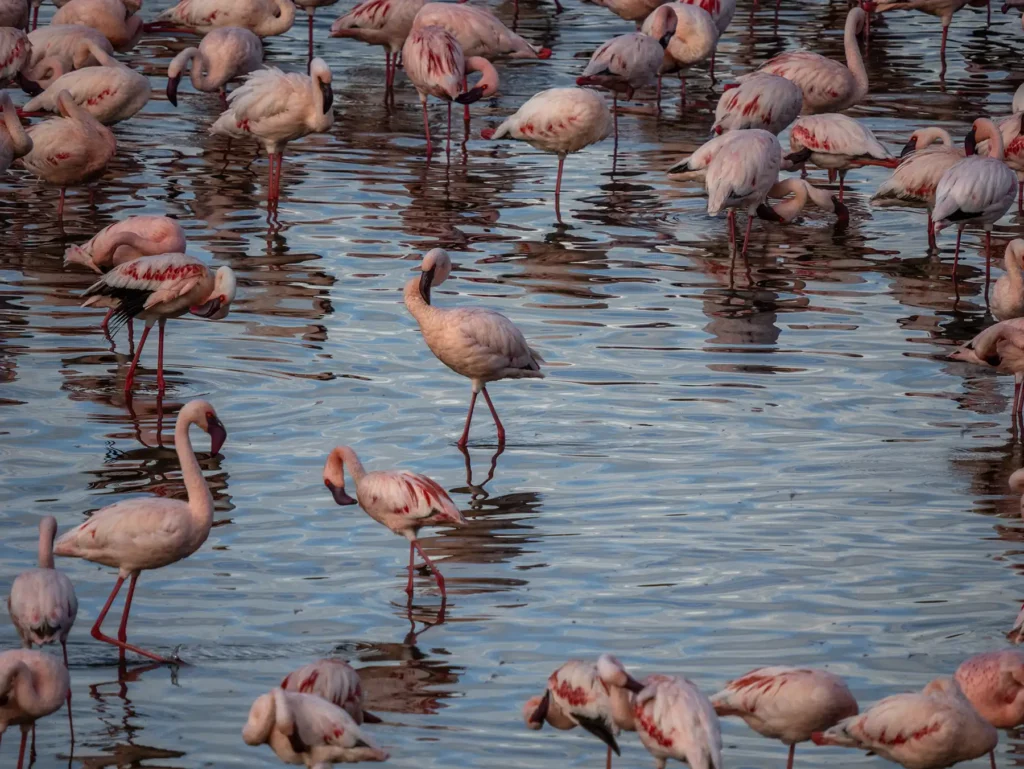
Tips for Visiting Lake Natron
Brace yourself for an adventure that’s as hot and dry as it is breathtaking. And with that comes the need to stay hydrated. Seriously, don’t skimp on the water. The heat around Lake Natron doesn’t mess around.
Long sleeves might seem counterintuitive in the heat, but they’re your best defence against the sun. Add a hat and some sturdy shoes, too. The terrain here is no joke, with rugged paths that can turn a leisurely walk into an ankle-twisting ordeal if you’re not careful.
Visiting a Maasai boma is a privilege that comes with its own set of responsibilities. These communities are welcoming but remember, you’re stepping into their world. Show the utmost respect for their traditions and customs. That means asking before you snap a photo—it’s not just polite, it’s acknowledging their dignity and agency.
Lake Natron’s ecosystem is as delicate as it is dramatic. It’s not any body of water; it’s a vital breeding ground for flamingos and a host of other wildlife, all of which rely on its fragile balance. Listen to your guide, stick to the paths, and do your part to ensure your visit leaves no trace on this unique environment.
And a heads up about the roads—calling them ‘rough’ is putting it mildly. The journey to Lake Natron is pretty wild. A high-clearance vehicle isn’t just a recommendation; it’s a necessity unless you fancy getting stranded in one of Tanzania’s most remote places. So, buckle up, it’s going to be a bumpy ride.
I’d also refrain from visiting Lake Natron in the rainy seasons as the roads are liable to flooding and become impassible.

My Experience Visiting Lake Natron
My visit to Lake Natron didn’t turn out as expected. I’d planned to spend the day wandering round the lake, marvelling at its bright pink colour, as well as hiking to the nearby waterfall. My dreams came to a crashing halt as we encountered an unexpected obstacle on the drive.
A powerful torrent of water was gushing across the road, branches and other bits of debris being dragged down the fast-flowing river which just yesterday was non-existent. A night of heavy rains had caused water to cascade down the Rift Valley and turn into an angry river, cutting through the only road to Lake Natron.
We pulled up beside the river and got out to inspect the water. Maasai herdsmen and their cattle were also waiting beside the river, occasionally throwing stones into the torrent to see how deep it was.
We were the first car to arrive at the scene, heading out early in order to have a full day at Lake Natron. As the minutes went by, more and more cars arrived. The same could be said for the other side of the river, a queue of six cars was now waiting patiently for the water to recede so they could cross.
One car on the other side of the river didn’t have the patience to wait several hours for the waters to recede. Feeling dangerously optimistic the driver drove straight into the river, the dark green Land Cruiser charging through the water, which was so deep it came up to just below the car’s windows.
I wasn’t surprised when the car became stuck, the engine roaring and black smoke billowing from all sides as the driver tried desperately to free the vehicle from some hidden hole beneath the water. Alas, his attempts were in vein and a rescue operation was launched.
I was surprised that the car had so many people in. At least 10 children were climbing out of the window’s being guided across the river by Maasai herdsmen. They had been on their way to school.
It was a terrible reminder not to attempt to cross a flooded river like this.
After 4 hours of waiting, we eventually turned around. Lake Natron was not meant to be that day.
You can watch a video my Lake Natron experience here. It’s included in the same video as my Arusha National Park experience.
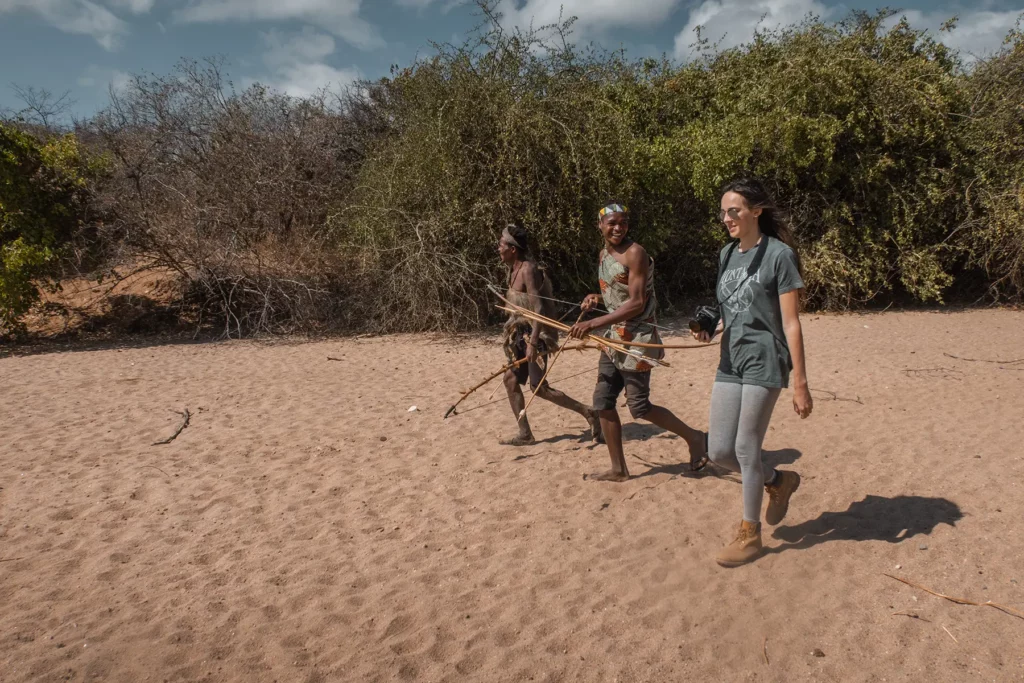
Day 6: Hadzabe and Datoga Tribes
Total drive time (excluding game drives): 2.5 hours
Today you will visit two of Tanzania’s 120 different tribes.
Heading out to hang with the Hadzabe and Datoga tribes is like stepping into a time machine, going back to the days when Tanzania’s ancient cultures were just doing their thing, untouched by the hustle and bustle of modern life. It’s a wild shift from spotting animals to mingling with those whose way of life hasn’t changed much in thousands of years.

Itinerary
Your day begins at dawn, setting out to join the Hadzabe tribe in their morning hunt. This experience offers a rare insight into a way of life that has remained unchanged for thousands of years.
The Hadzabe tribe are hunter-gatherers. They hunt for their meat and forage for fruit, tubers and honey. Meat makes up the majority of their diet and is extremely important to them.
Hunting with the Hadzabe is certainly no walk in the park. They walk at a brisk pace, at times through narrow trails that weave between thorny acacia trees. There’s no time to stop and catch your breath so having good stamina really is a must.
Witnessing them on a hunt is also not for the faint-hearted. Everything is on the menu, from the tiniest birds to large antelopes such as kudu. The Hadzabe hunt with a bow and arrows, and work with the assistance of hunting dogs.
Following this, visit a Datoga village, where you’ll witness the remarkable craftsmanship of these skilled metalworkers, known for their intricate beadwork and iron-smithing.
The afternoon sees you driving to Karatu, a peaceful town on the outskirts of the Ngorongoro Conservation Area, where you’ll spend the night amidst the cooler highlands.
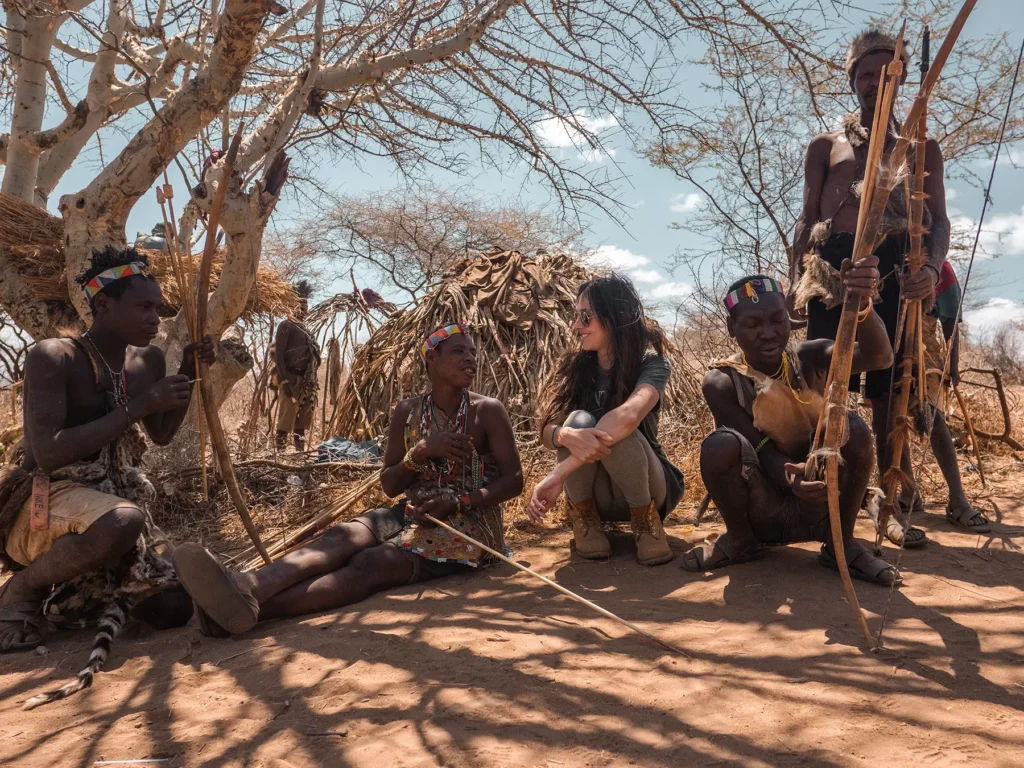
About the Hadzabe and Datoga Tribes
The Hadzabe, one of the last remaining hunter-gatherer tribes in Africa, continue to live a nomadic lifestyle in the vicinity of Lake Eyasi. Their existence is closely tied to the land, relying on hunting with bows and arrows and gathering wild fruits and honey.
The Datoga, on the other hand, are pastoralists and skilled metalworkers, whose history and culture is deeply interwoven with the land they inhabit.
Visiting these tribes offers an opportunity to observe and learn from cultures vastly different from our own, providing a deeper appreciation for Tanzania’s rich cultural tapestry.
Where to Spend the Night
After another day of exploration, retire to a lodge in Karatu or along the Ngorongoro Crater rim.
Options like the Gibb’s Farm offer a luxury getaway with its gardens and farm-to-table dining.
Alternatively, the Ngorongoro Wildlife Lodge perched on the crater rim offers breathtaking views and comfortable accommodations, making sure you get a restful night’s sleep under the African stars.

Tips for Visiting the Hadzabe and Datoga Tribes
These visits are a chance to peek into traditions and ways of life that have stood the test of time, and they deserve plenty of respect and sensitivity. This is their home, their life, and a little respect goes a long way in showing you appreciate the opportunity.
Listening might just be the most important thing you do on these visits. Keep your mind open, ready to soak up the wisdom and perspectives that are generously shared with you. These communities have a lot to teach about living in harmony with nature, with each other, and perhaps, ways of being that the wider world has forgotten or overlooked.
It’s natural to want to capture the moment, but remember, not everyone wants to be on camera. Always, and I mean always, ask for permission before you snap a photo. It’s a simple gesture that acknowledges the dignity of the people you’re meeting. Plus, it often opens up a channel for deeper interaction, turning a potential snapshot into a meaningful exchange.
There’s a lot to consider before you go for a hunt with the Hadzabe. Their hunts can take anywhere from a couple of hours to 5 or 6 hours. Generally, the Hadzabe hunt for as long as it takes to catch a decent haul and there’s no telling how long this could be. Therefore it’s essential that you’re in good levels of fitness before your hike.
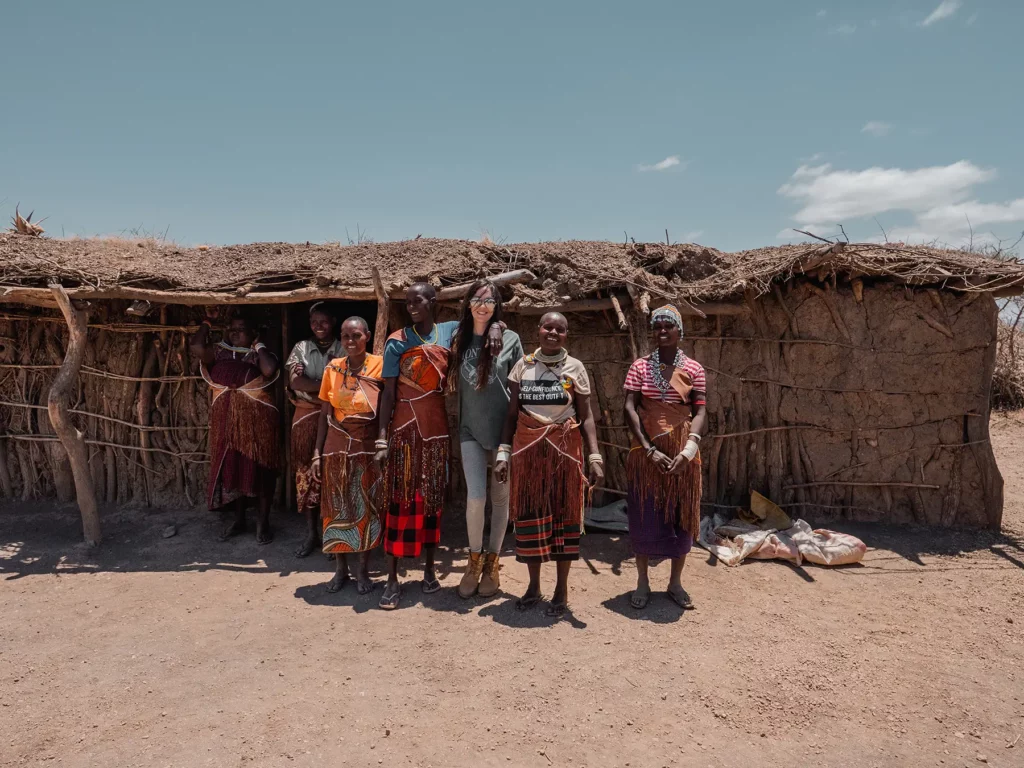
Take plenty of water with you – at least two bottles per person. Walking underneath the African sun is hot work so it’s essential that you keep hydrated.
When you’re hunting with the Hadzabe, the terrain can be challenging. You’ll be weaving between thorn trees and scrambling up and down rocky hillocks. Strong sturdy footwear and thick clothing to protect you from the thorns are a must. I wouldn’t wear anything you care too much about either as they could get scratched on the thorns.
Wear neutral clothing when out with the Hadzabe (greys, muted greens, browns and beiges). Anything bright will scare away the animals and spoil the hunt. Remember, the Hadzabe rely on these animals for food so it’s essential that you don’t negatively impact the hunt.
Picking up some local crafts isn’t just about snagging souvenirs—it’s about supporting the artisans and their way of life directly. And if you’re feeling particularly grateful for the hospitality and insights shared, a donation to the community can also be a powerful way to say thank you.
And lastly, when it comes to what to wear, think modestly. Dressing modestly shows that you’re aware of the values of your hosts and are there to observe and learn, not to impose your own standards. It’s a small adjustment on your part that can make a big difference in how your visit is received.
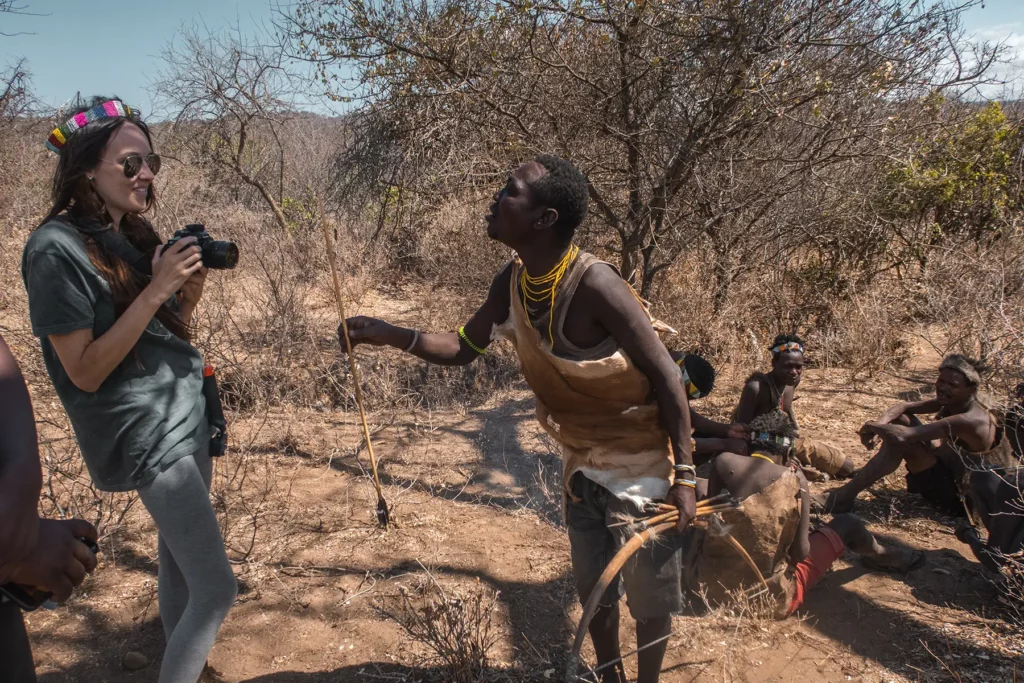
My Experience Visiting the Hadzabe and Datoga Tribes
I’ve visited the Hadzabe tribe twice now and each time provided me with a vastly different experience.
The first time I visited the Hadzabe was in the dry season. The tribe was living on flat ground, sheltered beneath a huge baobab tree. Embarking on a hunt involved traversing across relatively flat terrain in temperatures that were cool at first but eventually warmed up to a comfortable level where I could remove a layer of clothing.
In just a couple of hours the tribe caught three birds, one mouse, one dik-dik (a small antelope) and a white-tailed mongoose. The tribe saw signs of the mongoose’s presence long before they were able to catch it, pugmarks leading to a hole within a kjope. They then spent around an hour trying to capture the animal, sheltered within the rocks.
Whilst there had definitely been quite a bit of walking, I didn’t feel like the hunt had been too much of a strain so I had expected my second visit to be similar. Oh, how wrong I was!
My second visit took place in the short rainy season. The arrival of the rains meant that the tribe had moved to a cave which was at the top of a rocky hill. The cave provided them with shelter but it was also positioned in a much more challenging part of the Lake Eyasi basin to navigate around.
The hunt took us scrambling down the steep hill. The Hadzabe managed it with ease but I was slow and found it difficult to keep up. I sighed with relief when we were on flat ground but sadly it wasn’t for long.
Before I knew it we were scaling another hill. And then another. And then another. These hills are no joke. They are rocky and dotted with thorny bushes and plants that look like javelins. There’s no paths up and down these hills which makes it very challenging to navigate them. The constant ascents were also taking their toll on my energy levels. I was panting, sweating and thirsty. It was at that moment I realised I had made a grave mistake in only bringing one bottle of water as it was nearly finished and we were only an hour into the hunt.

The tribe had caught the trail of a bush pig – a huge catch if they could find it. They were incredibly persistent and thorough in their pursuit, ensuring we covered every stretch of ground for signs of the animal. The hours went by and I’m not going to lie, I was struggling. The midday heat, uneven challenging terrain and lack of water was making me weary and borderline delirious.
Just when I felt like my only option was to leave the group and go back to base, shouts alerted me that they had found what they’d been looking for.
As I stood, panting for breath on a dried-up riverbed, I heard frantic crashing coming from the bushes in front of me. I stared wide-eyed as the crashing got louder, knowing full well what was going to happen next yet somehow becoming paralysed with indecision of which direction to move.
The bushes parted and an enormous pig came charging towards me. I didn’t move, watching with horror as the massive pig came closer. At the last moment it veered away and I snapped out of my trance, racing after the pig alongside the Hadzabe.
Don’t make the same mistakes as me! Come prepared for a lengthy hike, bring plenty of water and if a bush pig is coming straight towards you, it’s a good idea to move out of the way!
You can view a video of my Hadzabe experience on Youtube.
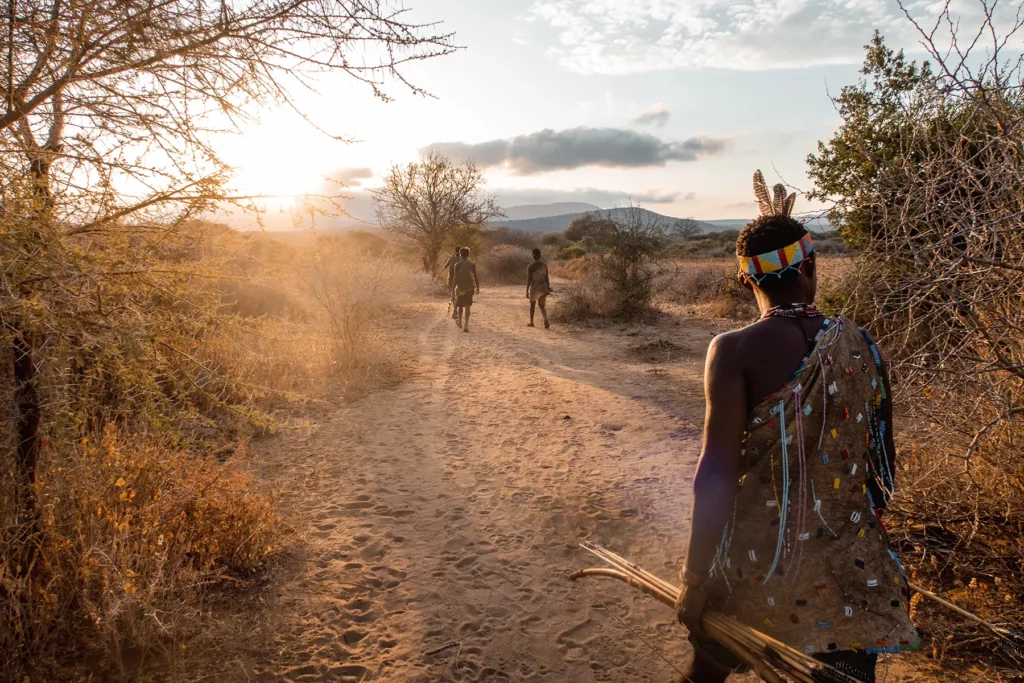
Day 7: Ngorongoro Crater
Total drive time (excluding game drives): 5 hours
Today you will embark on a safari in one of Tanzania’s natural wonders: Ngorongoro Crater.
Ngorongoro Crater is a completely unique safari destination, housing an enclosed ecosystem on wide open plains within its towering forest-coated walls.
Despite what the name would suggest, Ngorongoro Crater is actually the caldera of a collapsed ancient volcano which once stood higher than Mount Kilimanjaro.
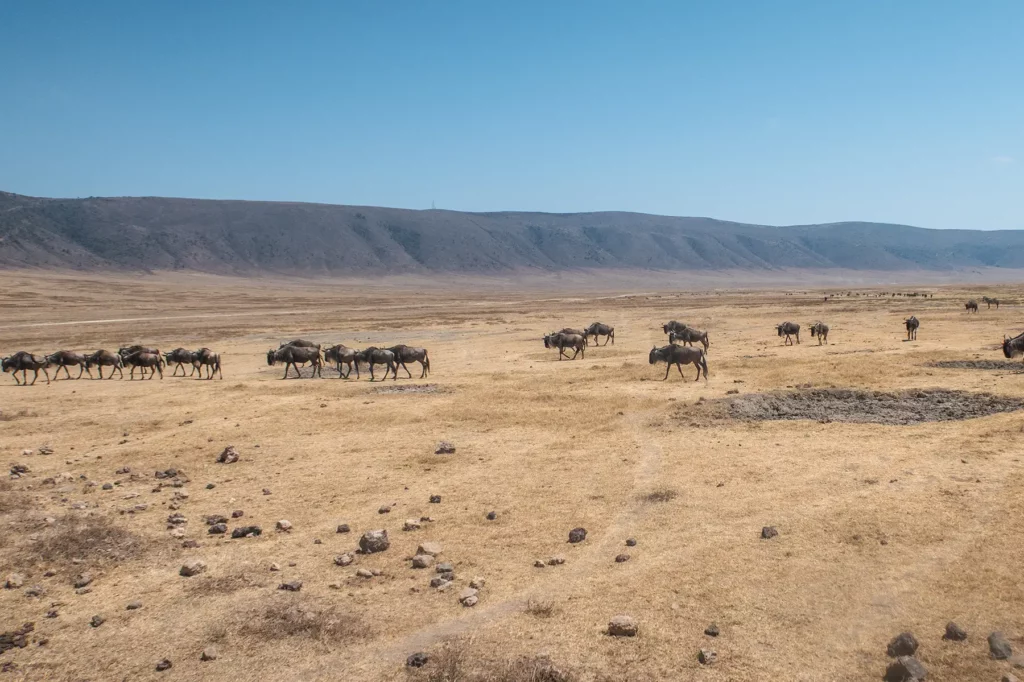
Itinerary
Your day begins with an early descent into the Ngorongoro Crater, the world’s largest intact volcanic caldera and the perfect place to spot more wildlife. This natural amphitheatre is home to over 25,000 large mammals, including the Big Five.
After a morning filled with wildlife sightings, you’ll start out on the journey to the Serengeti, traversing the highlands and vast landscapes that make Tanzania a premier safari destination. The drive itself is lots of fun, offering the chance to spot wildlife along the way. As you approach the Serengeti, the endless plains stretch to the horizon, which signal the start of your next safari chapter.
About Ngorongoro Crater
The Ngorongoro Crater, a UNESCO World Heritage Site, is a microcosm of African wildlife. This conservation area is unique, not only for its geological significance but also for the sheer amount of species that it supports.
The crater floor attracts a wide range of animals, making it one of the best places in Tanzania to see the all important Big Five in their natural habitat.
The high walls of the crater create a natural enclosure, offering game viewing opportunities in a truly breathtaking setting. The walls also mean that no migration takes place, making Ngorongoro a great place to view wildlife year-round.
Read my full guide to Ngorongoro Crater.

Where to Spend the Night
As you enter the Serengeti, your accommodation will depend on the time of year, aligning with the movements of the Great Migration.
Between January and March, when the migration is typically in the south, lodges or tented camps in the Ndutu region offer prime locations for witnessing this natural wonder.
For the rest of the year, Central Serengeti becomes the best area to stay. Lodges and tented camps here designed to blend into the environment, offering comfort and proximity to nature, which I love.
Tips for Visiting Ngorongoro Crater
Kicking off your day before the sun peeks over the horizon isn’t just about catching those first golden rays—it’s your ticket to the Ngorongoro Crater’s morning show. This is when the wildlife is most active, not yet languid from the day’s heat. Beating the crowds gives you more of an experience with the crater’s inhabitants, making those early wake-up calls worth every second.
Ngorongoro’s got its own unique climate going on. The rim of the crater can be chilly, especially in those early hours or as the sun starts to dip. But venture down to the crater floor, and you’ll be peeling off layers. So, layer up and stay adaptable and comfortable as you move between these microclimates.
Remember, the crater is a carefully protected ecosystem that’s home to an incredible array of wildlife. This means sticking to the beaten path (literally) and keeping a respectful distance from the animals. These rules aren’t there to cramp your style; they’re in place to make sure the Ngorongoro Crater remains as awe-inspiring for future visitors as it is for you.
Don’t head out without a solid pair of binoculars. Sure, you’ll get to see a lot up close, but some of the crater’s residents might be a bit more reserved. With a good pair of binos, you’ll bring those distant lions and elusive rhinos right into your personal viewing bubble.

My Experience Visiting Ngorongoro Crater
Ngorongoro Crater is unlike anywhere else in the world! The experience of going on a safari here is simply magical, from start to finish.
In the morning, a buildup of mist covers the crater rim, providing a surreal and eerie experience as you drive to the crater’s descent road. I absolutely loved staring out the window at the dense swathes of forest which were cloaked in clouds.
Laying eyes on the inside of the crater for the first time, I was filled with awe. I felt like I was entering some long-forgotten world, unable to contain my excitement as we gradually descended hundreds of metres towards the vast crater floor.
It was on the crater floor where I saw my first ever hyena, golden wolf and even a serval cat! As I watched the spotted cat stroll through the long grass, I became aware that there was not just one of these beautiful creatures here but a whole family of them. They were on the hunt, waggling their haunches as a mouse caught their attention before landing squarely on the small mammals with scary precision.
Whilst I may not have seen the elusive black rhino that the crater is famous for, I did see a large herd of buffalo, a family of elephants, a group of basking lions and much more.
You can watch a video my Tanzania tribes experience below.
Day 8 – 10: Serengeti National Park
Total drive time (excluding game drives): Varies depending on specific locations within the park.
The Serengeti National Park, a name that conjures images of vast plains and endless skies, is the epitome of the African safari experience. The name literally means ‘endless plains’ in the local Maasai language.
The Serengeti has one of the highest densities of big cats of anywhere in Africa and is the stage of the Great Migration, the second largest terrestrial mammal migration which sees millions of wildebeest, zebra and antelopes traverse the Serengeti’s vast open plains in search of fresh grazing.
Spanning days 8 to 10, your journey through this iconic landscape offers an opportunity to be involved in the heart of the wild.
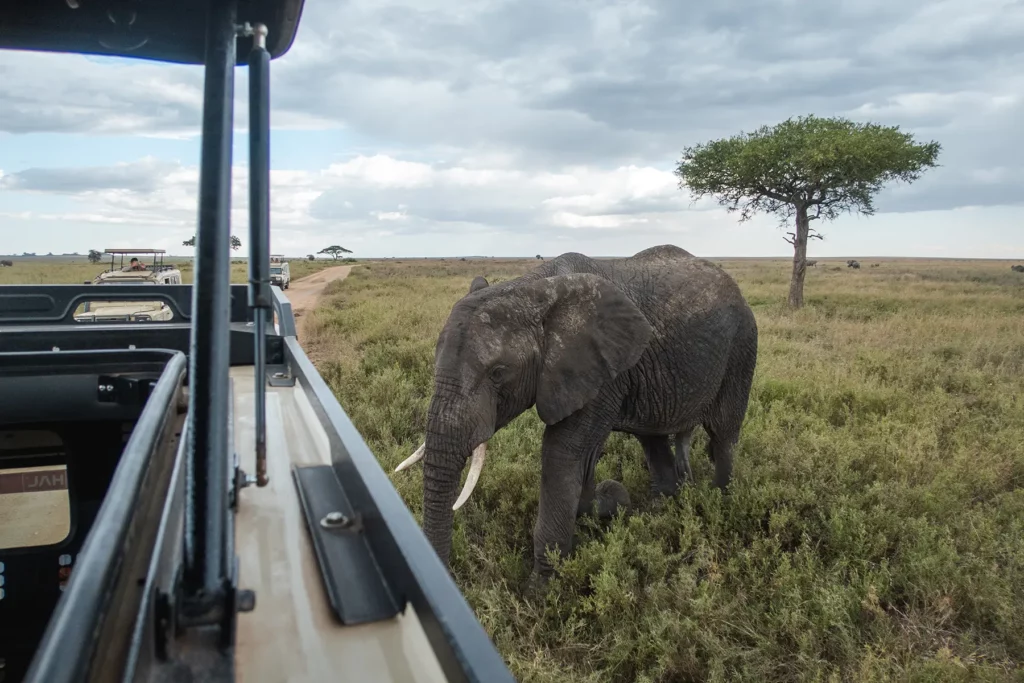
Itinerary
Your days in the Serengeti are marked by full-day game drives that promise ever-changing wildlife drama.
Each day begins with the light of the dawn, as you venture into the park to witness the natural world wake up.
The Serengeti’s vastness allows for exploration, from the kopjes, home to lions and leopards, to the great rivers teeming with hippos and crocodiles.
As the Great Migration moves, so does your focus, from the calving in Ndutu to the dramatic river crossings in the north.
Evenings are spent recounting the day’s adventures under a canopy of stars, enveloped in the sounds of the African night.
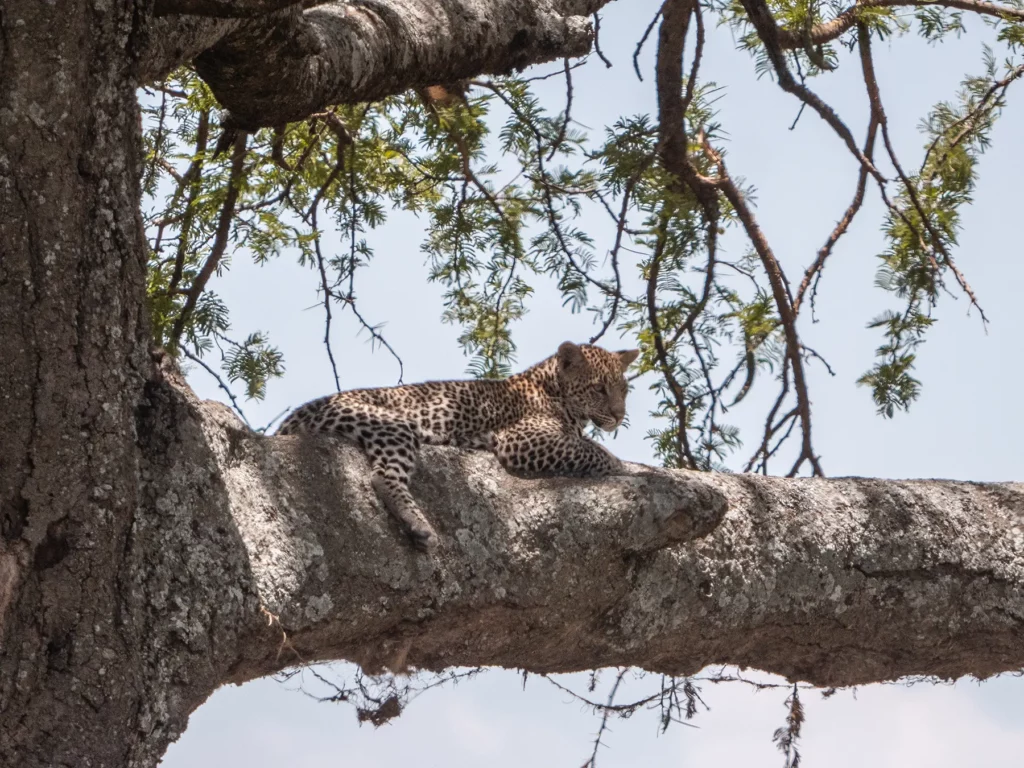
About Serengeti National Park
The Serengeti National Park, a UNESCO World Heritage site, is famed for its annual migration of over 1.5 million wildebeest and hundreds of thousands of zebras and gazelles. This vast ecosystem, spanning over 14,750 square kilometres, is also home to a rich diversity of wildlife, including the Big Five, making it one of the most sought-after safari destinations in the world.
The Serengeti’s landscape is varied, featuring open grasslands, acacia woodlands, and rocky outcrops or kopjes, each supporting its own wildlife.
As day turns to night, the Serengeti doesn’t sleep; it just changes, offering a glimpse into the nocturnal activities of its more elusive creatures, under a sky so littered with stars, it leaves every visitor in awe. This ever-changing landscape ensures that no two visits are the same, promising endless adventures.
Read my full guide to Serengeti National Park.
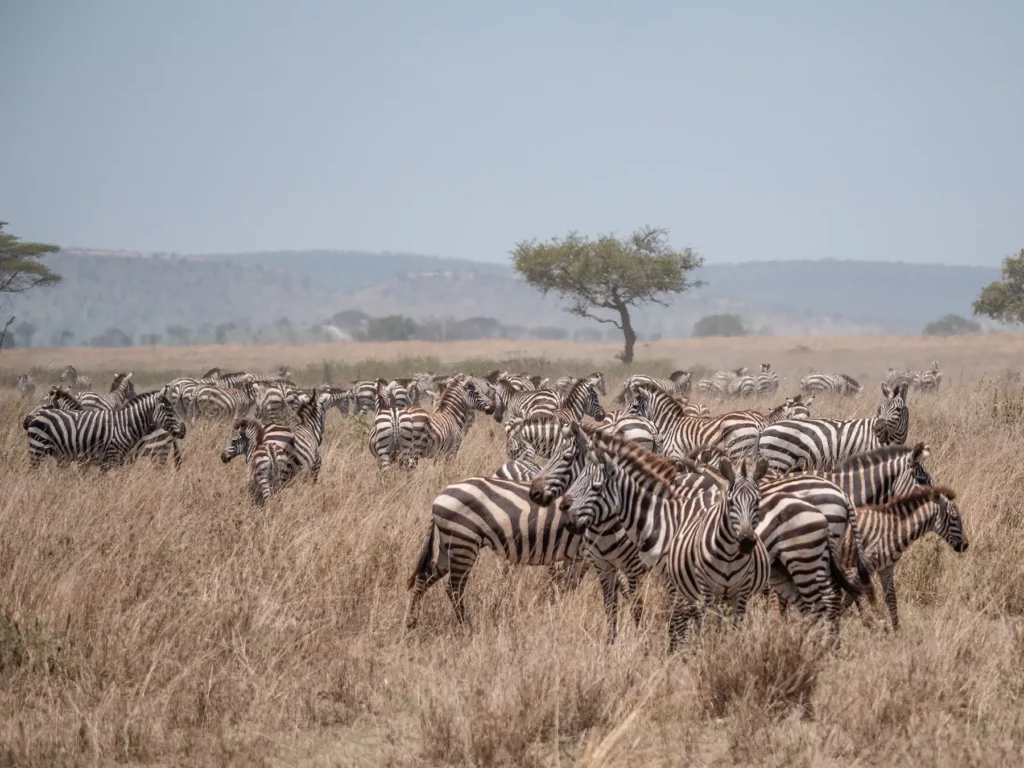
Where to Spend the Night
Accommodation in the Serengeti is located to offer the best game viewing opportunities, varying with the seasons to follow the Great Wildebeest Migration.
From January to March, lodges and tented camps in the Ndutu area in Southern Serengeti provide front-row seats to the calving season.
In June to October, staying in Northern Serengeti is ideal for witnessing the river crossings.
The Central Serengeti, with its year-round wildlife, offers a variety of options, from tented camps to permanent lodges, ensuring game viewing no matter the season.
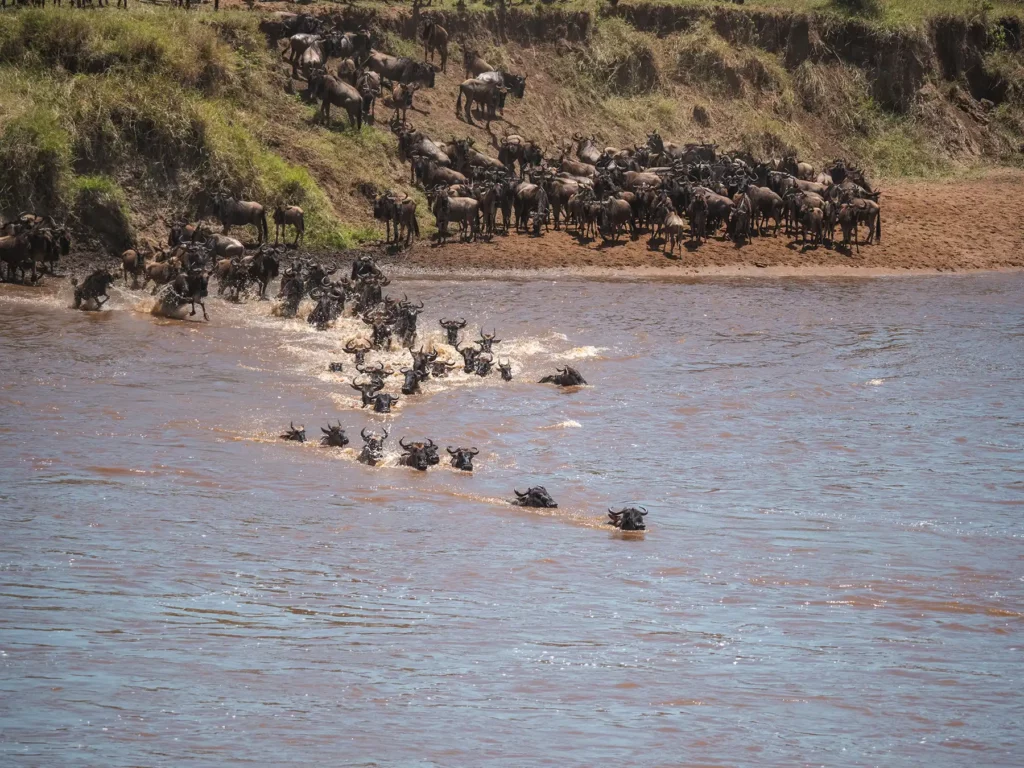
Tips for Visiting Serengeti National Park
You’re stepping into the living room of some of the planet’s most majestic creatures. So, when you’re out there, remember to give these animals the space they deserve. Keep a respectful distance – that’s what zoom lenses are for. They let you capture the lions’ yawns and the gazelles’ leaps without getting in their personal space.
When night falls over the Serengeti, it’s a whole different world. This isn’t the place for midnight strolls. Staying within the safety of your camp isn’t just a suggestion; it’s a must. The Serengeti doesn’t sleep when the sun goes down, and you’ll want to be safely tucked away, listening to the night sounds from the right side of the fence.
Lastly, this park is ours to enjoy but also ours to protect. Embrace the Leave No Trace principles. It’s all about making sure the Serengeti remains as untouched and majestic for the next generation of wildlife enthusiasts as it was for us. This means taking only memories, leaving only footprints (on the designated paths, of course), and keeping the wild in the wilderness for years to come.
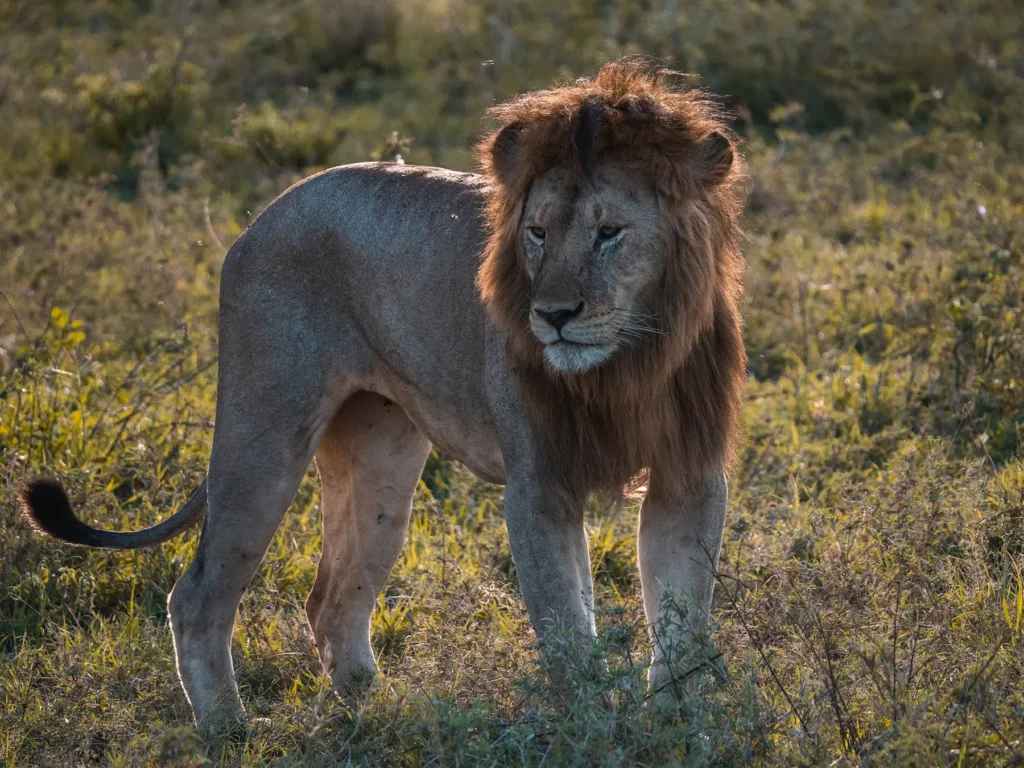
My Experience Visiting Serengeti National Park
I think the Serengeti may be my favourite safari destination in the world. Big claim, I know. But I’ve had some wonderful experiences to back it up.
My first full day in the Serengeti saw me driving up to the banks of the Mara River in September, just in time to see a bold wildebeest take the plunge into the Mara River, followed by hundreds more. They were bleating as they journeyed in a neat line across the raging river. Occasionally one would jump in fright and separate from the group, scared by some hidden danger.
The group made it across with no casualties and, just as quickly as it started, it stopped. Dozens of wildebeest were still milling about on the bank opposite to us but they were nervous, shifting uneasily as they eyed the murky fast-flowing water.
Our guide advised us to move on, citing that the wildebeest probably wouldn’t continue crossing for another couple of hours. I reluctantly agreed. What I didn’t know was that he’d heard on the radio about another crossing just a bit further up the river.
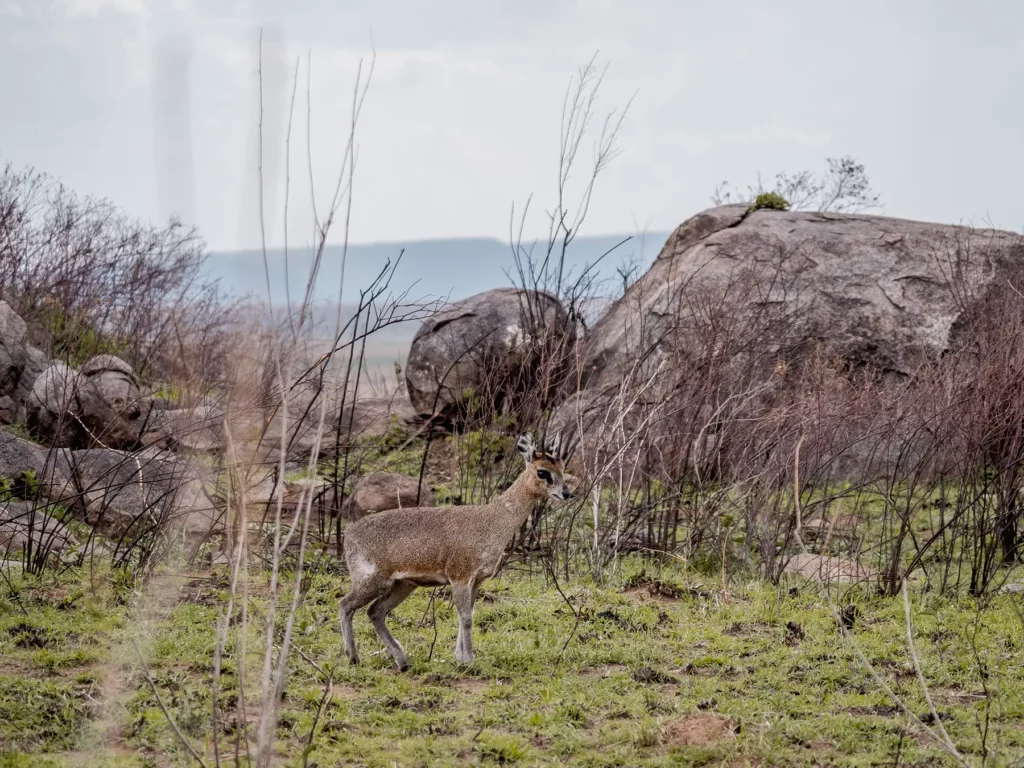
The second crossing was even more dramatic than the first. The water here seemed even stronger and countless wildebeest were pulled of course, feebly fighting against the strong current.
I counted at least four huge crocodiles lying in wait. They were so still, you’d be forgiven for mistaking them for stones.
A young wildebeest was having a particularly difficult time, dragged downstream to an area of river surrounded by steep embankments that he’d have no chance of climbing. He didn’t have the strength to swim back to the rest of the herd and the safe crossing point. And so we looked on as eventually a crocodile took him. Nature can be raw.
Later that day, we encountered a pair of mating lions, two cheetahs enjoying a freshly-killed wildebeest and a beautiful lioness in a tree. The Serengeti is one of the few places where you can witness this unique behaviour.
The following day was filled with big cat sightings. I saw more lions than I could count, including a lioness hunting a zebra, another cheetah and three leopards!
You can watch a video my Serengeti experience below.
Day 11: Zanzibar
Total drive time (excluding game drives): Dependent on what activities you do
Today you will leave the Serengeti and fly to the beautiful island of Zanzibar.
Transitioning from the wild heart of the Serengeti to the spice-scented breezes of Zanzibar offers a great contrast on the eleventh day of your Tanzanian adventure.
This island provides the most amazing conclusion to the safari experience, inviting relaxation along its beaches and exploration of its historic sites.

Itinerary
Begin your day with an early morning game drive in the Serengeti, savouring your last moments in the African bush.
As the day progresses, you’ll depart from the savannah via a plane from one of the Serengeti’s airstrips, flying to the Zanzibar Archipelago, where the Indian Ocean meets African soil.
When you arrive, the rest of your day is at your leisure, allowing you to acclimatise to the island’s laid-back pace and tropical beauty.
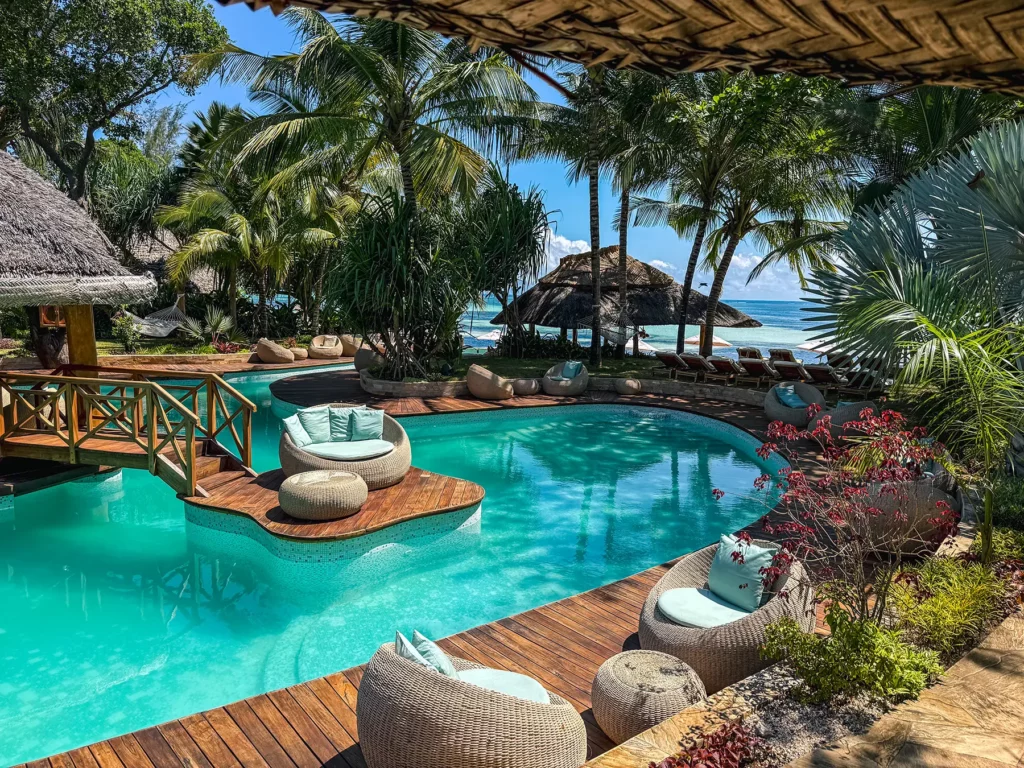
About Zanzibar
Zanzibar, also known as Unguja, is the main island in the Tanzanian archipelago of the same name.
It’s famed for its fascinating history, evident in the Stone Town, a UNESCO World Heritage site, with its labyrinthine alleys, carved doorways, and markets.
Beyond this, Zanzibar is renowned for its beaches, coral reefs, and the clear, warm waters of the Indian Ocean, making it a paradise for beach lovers, snorkellers and divers alike.
Learn more by reading my Ultimate Guide to Zanzibar.
Where to Spend the Night
Zanzibar boasts many beachfront hotels designed to maximise your enjoyment of the island. I’d highly recommend choosing a hotel or guesthouse on the beach rather than an inland one.
For a luxurious stay, consider the Zuri Zanzibar Hotel & Resort, nestled on the shores of Kendwa Beach, known for its stunning sunsets and crystal-clear waters.
Alternatively, the Park Hyatt Zanzibar offers a blend of modern luxury and Swahili culture in the heart of Stone Town, with easy access to the beach and historical sites.
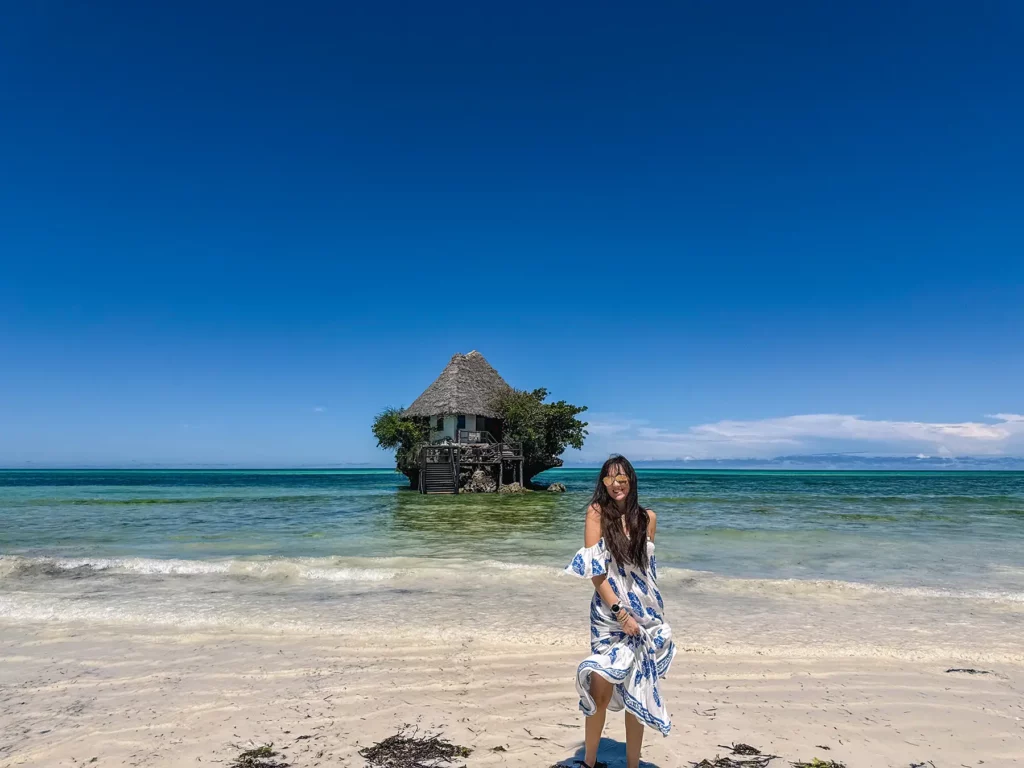
Tips for Visiting Zanzibar
Slipping into Zanzibar’s groove means dialling back the pace and really soaking in those laid-back, island vibes. This place doesn’t do hustle and bustle; it’s all about the slow and steady, letting you catch every little detail that makes the island so special. So, take a deep breath, slow down, and let Zanzibar’s rhythm guide you.
Dressing a bit more conservatively out of the water is a simple way to show your respect for the local way of life as Zanzibar has a primarily Muslim culture. It’s all about blending in, respecting the culture, and making sure you’re part of the vibe, not against it. Opt for tops that cover your shoulders and trousers or skirts that fall below your knees.
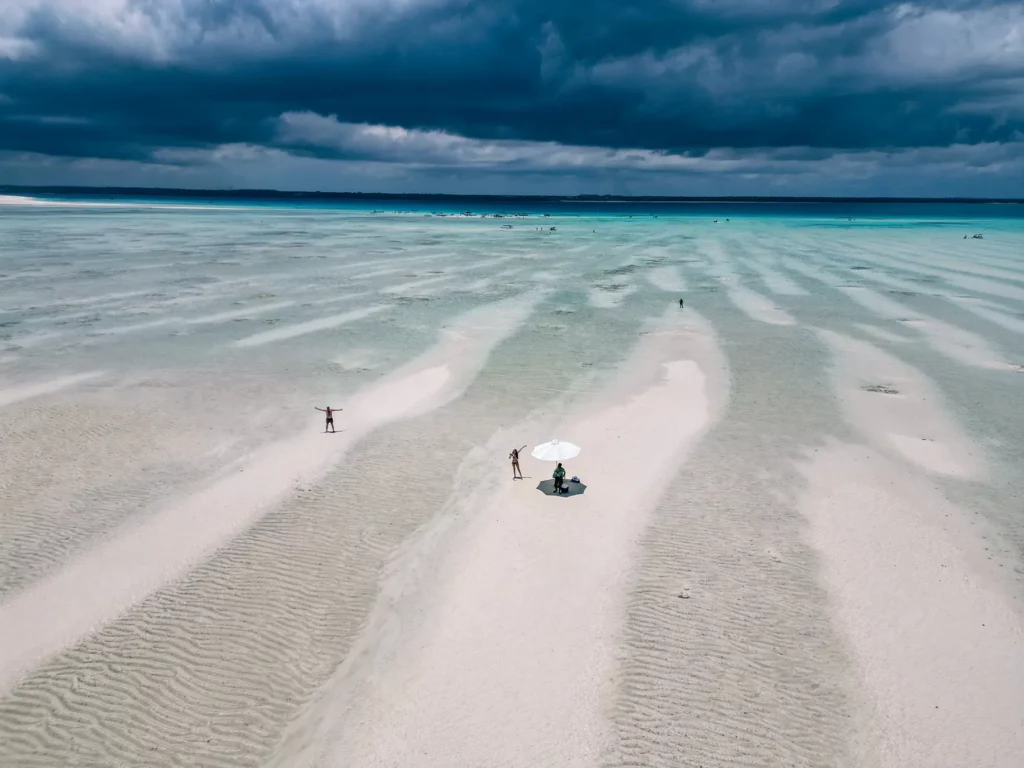
If you’re into seafood, you’ve hit the jackpot. Zanzibar’s surrounded by the Indian Ocean, which means it’s seafood central. We’re talking about the freshest of the fresh, spiced up with those mouthwatering Swahili flavours. Whether it’s grilled octopus, lobster, or a simple fish curry, it’s all about savouring those zesty, aromatic spices.
Whether you’re snorkelling over coral reefs or just chilling on the beach, slather on that reef-safe sunscreen. It’s not just about dodging a sunburn; it’s about protecting those stunning underwater worlds from harmful chemicals. Plus, it keeps your skin happy and the fish even happier.
Another thing to bear in mind on Zanzibar, one minute you’re looking at an endless stretch of sand, and the next, the sea has crept up to kiss your toes. When planning your beach days, keep an eye on the tide schedules; they’ll tell you when to lay out your towel for a sunbath or when it’s best to explore the underwater world.
As you wander through Stone Town’s winding streets or dive into the deep blue, keep in mind the footprint you leave behind. Exploring responsibly means embracing the beauty of Zanzibar while ensuring it stays beautiful for everyone after you. It’s about being a mindful traveller, one who appreciates the culture, respects the environment, and leaves only footprints in the sand.
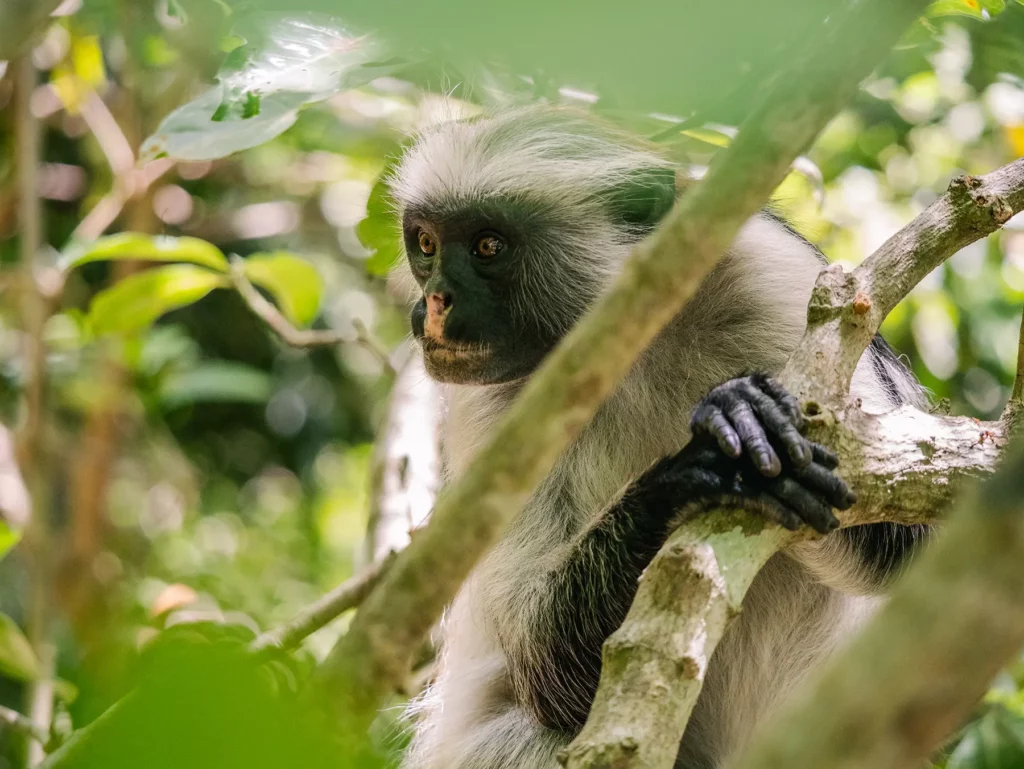
Day 12 – 14: Zanzibar
Total drive time (excluding game drives): Minimal, as most activities and accommodations are within a short distance of each other on the island.
The final days of your Tanzanian adventure unfold on the tranquil island of Zanzibar. These days are yours to relax on the island, explore its natural wonders, and simply chill out on its sun-kissed beaches. Zanzibar offers a perfect blend of relaxation and exploration, ensuring your adventure ends on a high note.
These last days will allow you to unwind and reflect on the incredible journey you’ve experienced in Tanzania. From the wilds of the Serengeti to the tranquil shores of Zanzibar, this adventure will offer you something incredible that you will definitely be telling the grandkids.
Things to Do in Zanzibar
Zanzibar is a literal treasure trove of experiences, from the historical alleys of Stone Town to the incredible beaches and coral reefs. Here are some highlights to consider:
1. Relax on the Beach
Zanzibar’s beaches are legendary, offering powdery white sands and clear turquoise waters.
Nungwi and Kendwa beaches in the north are perfect for swimming and sunbathing, thanks to their minimal tidal impact.
Paje and Jambiani on the southeast coast offer wide, quiet beaches ideal for relaxation or something a bit adventurous like kite surfing.
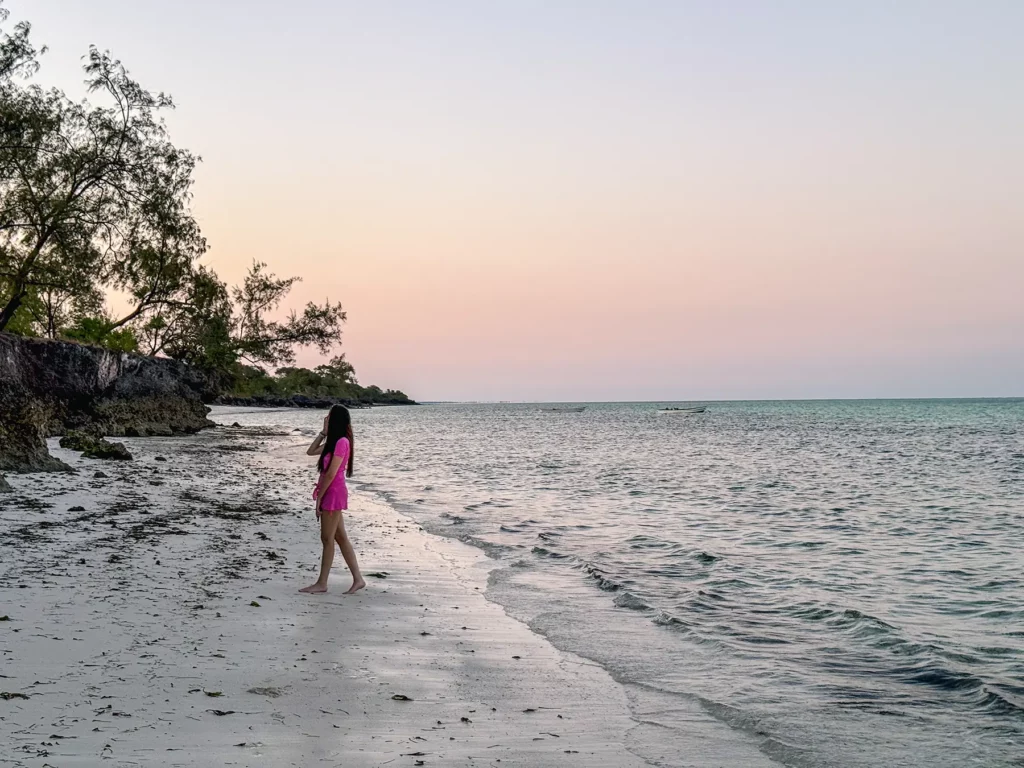
2. Go Snorkelling
The island is surrounded by some of the most well known coral reefs in the Indian Ocean.
Mnemba Atoll is a snorkelling paradise, where the clear waters teem with colourful fish and coral gardens.
Chumbe Island Coral Park is another excellent spot, offering pristine reefs and a protected marine reserve.
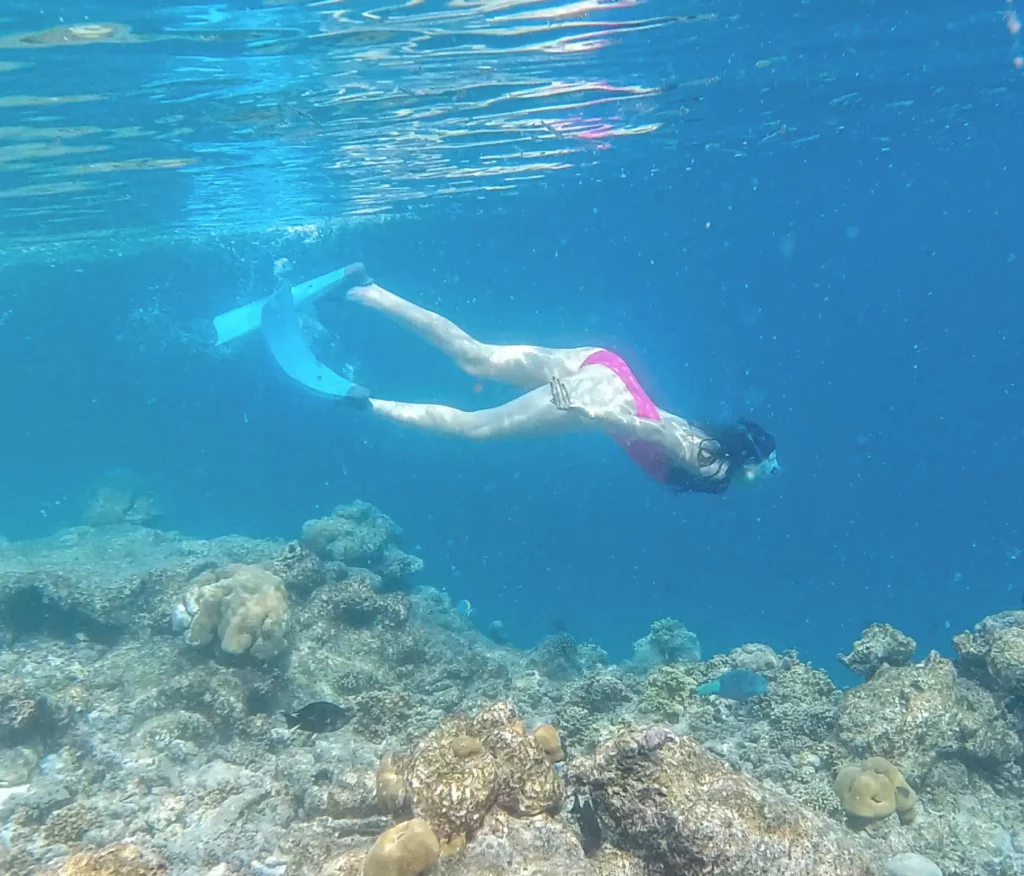
3. Visit Stone Town
The heart of Zanzibar, Stone Town, is a labyrinth of narrow streets, carved doorways and bazaars.
Highlights include the Sultan’s Palace, the Old Fort, and the House of Wonders.
Don’t miss the opportunity to wander the markets, where the air is fragrant with spices, and the vibrant textiles and handcrafted items beckon.
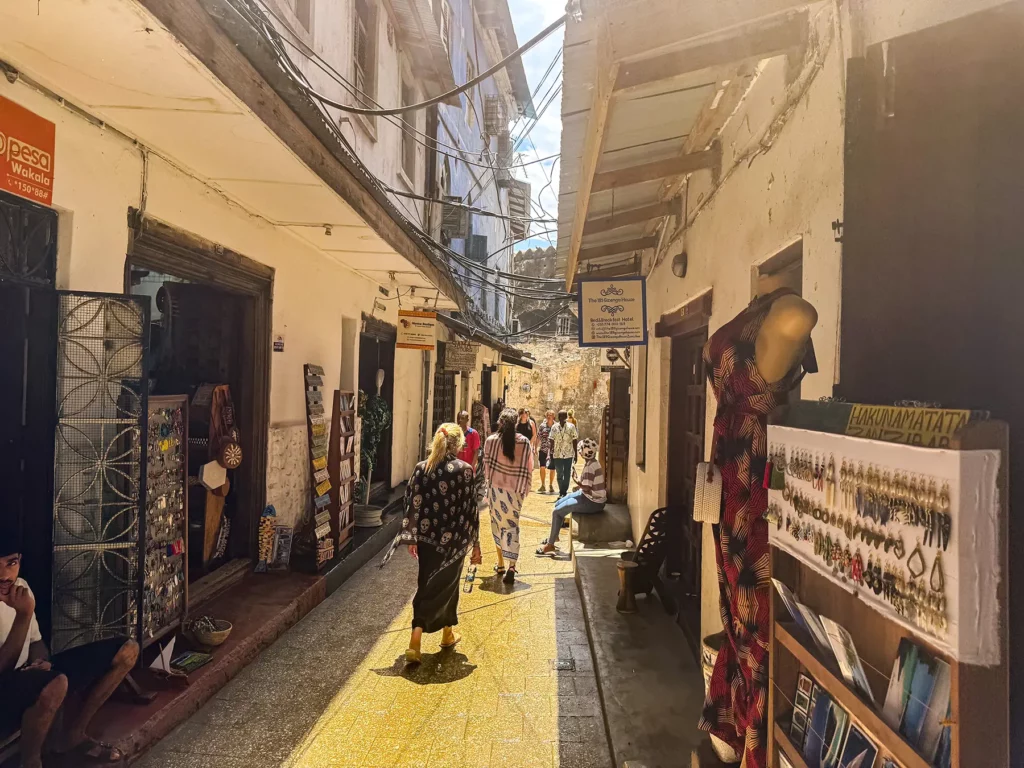
Where to Spend the Night
In my opinion, your nights in Zanzibar should be as memorable as your days.
Beachfront hotels like the Zanzibar White Sand Luxury Villas & Spa in Paje offer luxurious accommodations with direct access to the beach.
For a more lively atmosphere, the DoubleTree by Hilton Hotel Zanzibar – Nungwi provides comfortable rooms and easy access to local nightlife and water activities.
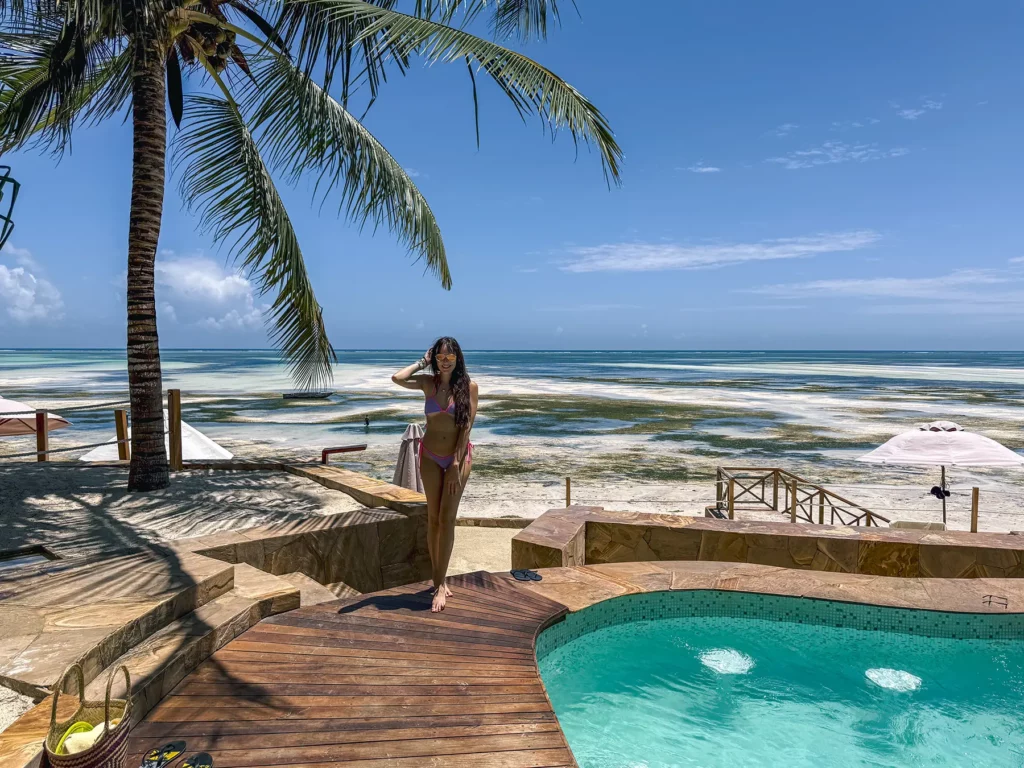
Recommended Booking Options For Your 2-Week Tanzania & Zanzibar Itinerary
Private Safari
Most popular & best experience – typical prices for this itinerary start from $350 per person per day.
Visit safarisbyella.com for free quotes from trustworthy local tour companies I use to book my own trips.
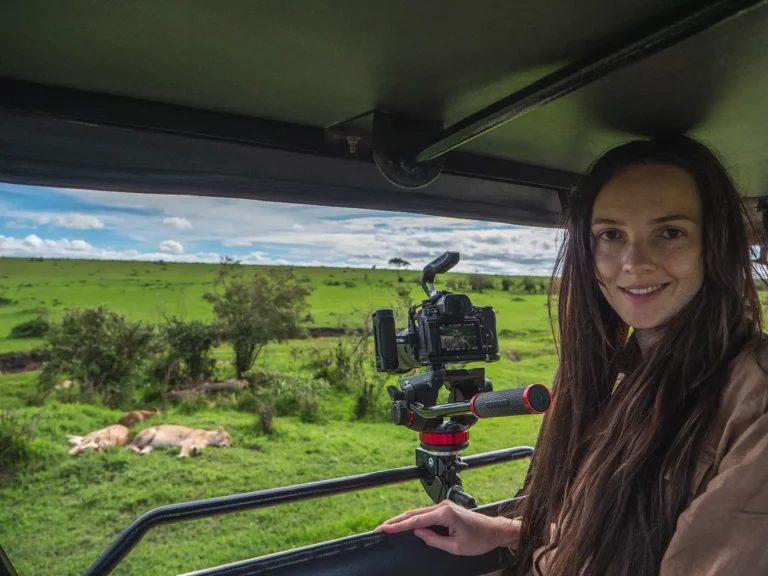
I could not find any group safaris following this or any similar itineraries. See my guide(s) below for better group budget options.
Final Thoughts
A 2-week itinerary through Tanzania allows you to experience the country’s highlights, from the wild Serengeti to the peaceful beaches of Zanzibar.
Whilst it’s certainly possible to visit Tanzania in a 7-10 day itinerary, this 2-week itinerary just allows you that bit longer at each location, ensuring you have a more leisurely and thorough experience.
Read More Tanzania Guides
For an overview of planning your safari, you can read my Ultimate Tanzania Safari Guide.
Tanzania Itineraries
Recomended itineraries and how to book them.
7-10 Day Tanzania Safari Itinerary & Costs
5-Day Tanzania Safari Itineraries & Costs (6 unique Itineraries)
3-Day Tanzania Safari Itinerary & Costs
2-Week Tanzania & Zanzibar Safari Itinerary & Costs
3-Week Tanzania Safari Itinerary & Costs
10-Day Tanzania Honeymoon Itinerary & Costs
Tanzania and Kenya Itineraries
Multi-country itineraries and how to book them.
10-Day Kenya and Tanzania Safari Itinerary
2-Week Kenya & Tanzania Safari Itinerary
Costs & Planning
How to get the most bang for your buck and the best time of year to visit depending on what you want to do and see.
Tanzania Safari Cost – Everything You Need to Know!
The Great Wildebeest Migration Guide
Zanzibar Island – The Complete Guide
National Parks & Reserves
Complete guides to the best and most famous safari reserves, including the wildlife you’ll see, entrance costs and best time to visit.
Other Popular Safari Destinations
How to Book Your Safari
Save time and ensure an incredible safari experience by getting quotes from my recommended local safari companies.
Join the rapidly growing tribe of over 1,000 travellers who’ve booked their dream safari using my insider tips and recommendations.

